- Home
- About
- Map
- Trips
- Bringing Boat West
- Migration West
- Solo Motorcycle Ride
- Final Family XC Trip
- Colorado Rockies
- Graduates' XC Trip
- Yosemite & Nevada
- Colorado & Utah
- Best of Utah
- Southern Loop
- Pacific Northwest
- Northern Loop
- Los Angeles to NYC
- East Coast Trips
- Martha's Vineyard
- 1 Week in Quebec
- Southeast Coast
- NH Backpacking
- Martha's Vineyard
- Canadian Maritimes
- Ocracoke Island
- Edisto Island
- First Landing '02
- Hunting Island '02
- Stowe in Winter
- Hunting Island '01
- Lake Placid
- Chesapeake
- Provincetown
- Hunting Island '00
- Acadia in Winter
- Boston Suburbs
- Niagara Falls
- First Landing '99
- Cape Hatteras
- West Coast Trips
- Burning Man
- Utah Off-Roading
- Maui
- Mojave 4WD Course
- Colorado River Rafting
- Bishop & Death Valley
- Kauai
- Yosemite Fall
- Utah Off-Road
- Lost Coast
- Yosemite Valley
- Arizona and New Mexico
- Pescadero & Capitola
- Bishop & Death Valley
- San Diego, Anza Borrego, Joshua Tree
- Carmel
- Death Valley in Fall
- Yosemite in the Fall
- Pacific Northwest
- Utah Off-Roading
- Southern CA Deserts
- Yosemite & Covid
- Lake Powell Covid
- Eastern Sierra & Covid
- Bishop & Death Valley
- Central & SE Oregon
- Mojave Road
- Eastern Sierra
- Trinity Alps
- Tuolumne Meadows
- Lake Powell Boating
- Eastern Sierra
- Yosemite Winter
- Hawaii
- 4WD Eastern Sierra
- 4WD Death Valley +
- Southern CA Deserts
- Christmas in Tahoe
- Yosemite & Pinnacles
- Totality
- Yosemite & Sierra
- Yosemite Christmas
- Yosemite, San Diego
- Yosemite & North CA
- Seattle to Sierra
- Southwest Deserts
- Yosemite & Sierra
- Pacific Northwest
- Yosemite & South CA
- Pacific Northwest
- Northern California
- Southern Alaska
- Vancouver Island
- International Trips
- Index
- Tips
- Books
- Photos/Videos
- Search
- Contact
Mono Lake
Saturday, November 13, 2021 - 3:30pm by Lolo295 miles and 6 hours from our last stop - 1 night stay
Travelogue
 Tufas and SierraDeath Valley was a pretty long drive for one day, so we decided to break it up by spending the night in Lee Vining, near Mono Lake.
Tufas and SierraDeath Valley was a pretty long drive for one day, so we decided to break it up by spending the night in Lee Vining, near Mono Lake.
We absolutely love Mono Lake. It is such a unique and otherworldly place with its mystical “tufa castles” rising from the lake, formed over thousands of years when carbonates in the water combined with calcium from freshwater springs feeding into the lake.
Normally they would just be hidden beneath the water, but as lake levels dropped, these extraordinary-looking knobs, spires, and minarets became exposed, some of them rising as high as 30 feet above the surface—and they do look like castles. Most of the towers visible in the lake are from 200 to 900 years old.
 Herb awaiting sunriseThe largest concentration of them can be found along the southern shore of the lake at the South Tufa State Reserve, just ½ mile west of Navy Beach.
Herb awaiting sunriseThe largest concentration of them can be found along the southern shore of the lake at the South Tufa State Reserve, just ½ mile west of Navy Beach.
We got to Lee Vining too late to enjoy the sunset over the lake, so we decided to set our alarm clocks for 5:00 to catch the sunrise in the morning. I’m not a morning person, so this was a big deal for me.
While it was still dark we drove down 395, turned east on Highway 120, and made another left on the turnoff for the South Tufa State Reserve. I was surprised to see that we were not the first ones there.
 Sunrise Mono LakeAs we got our stuff together to hike the short distance to the tufas, several more cars arrived. As They began unloading lots of camera and video equipment, we realized that they were all together and some kind of filming was going to be done. I asked them and they said that they were filming a nature documentary for the BBC.
Sunrise Mono LakeAs we got our stuff together to hike the short distance to the tufas, several more cars arrived. As They began unloading lots of camera and video equipment, we realized that they were all together and some kind of filming was going to be done. I asked them and they said that they were filming a nature documentary for the BBC.
Looks like we were in the right place for some pretty spectacular scenery.
The trail to the lake is only a mile-long, but there were plenty of interesting stops along the way. Because of the drop in lake levels over the years, there are quite a few land-based tufas along the trail. That, combined with the snow-capped Sierras in the background, made for a very lovely scene.
 Sunrise Mono LakeIt was a frigid 37 degrees and my fingers, despite a pair of gloves, were freezing, making it difficult to hit the shutter on my camera phone.
Sunrise Mono LakeIt was a frigid 37 degrees and my fingers, despite a pair of gloves, were freezing, making it difficult to hit the shutter on my camera phone.
Meanwhile more and more members of the film crew went by rolling suitcases filled with equipment. I hoped we wouldn't get in each other’s way. I didn't get up this early to have dozens of people in my photos. I'm sure they felt the same about us.
We got to a small beach on the lake and waited for the sun to make its appearance, right over the peaks of those beautiful snow-capped Sierras. What a difference some snow makes. The Sierra is always beautiful, but when it's covered in a blanket of snow, it is striking.
 Sunrise Mono LakeFinally, at 6:35, right on time, the tops of the peaks took on an orange glow, as if a painter was starting his work. By 6:50 the show was in full force, with the mountains and the tufas all aglow - both in reality and in their reflections in Mono Lake. It was absolutely stunning.
Sunrise Mono LakeFinally, at 6:35, right on time, the tops of the peaks took on an orange glow, as if a painter was starting his work. By 6:50 the show was in full force, with the mountains and the tufas all aglow - both in reality and in their reflections in Mono Lake. It was absolutely stunning.
We wandered a bit further along the lake trying to stay out of the way of the BBC crew, who were now flying drones over the entire area, capturing the Sierra, lake, and tufas from above. I wish I had asked when this documentary would be aired. I didn't even know what it would b e called.
 Historic Benton Hot SpringsOnce the sun had risen and completed its light show, with frozen hands we went back to the car to continue on our way to Death Valley.
Historic Benton Hot SpringsOnce the sun had risen and completed its light show, with frozen hands we went back to the car to continue on our way to Death Valley.
Although the shortest route was down 395 to the town of Lone Pine and then east on 190 towards Stovepipe Wells, we decided to take another more scenic and interesting route.
From the South Tufa Reserve, we continued east on 120 to the town of Benton, famous for its historic natural hot springs. No time for soaking now, so we continued on to the town of Tonopah, an historic Nevada mining town, before heading south of 95 towards Rhyolite and the Titus Canyon 4WD entrance into Death Valley.
See next stop
Yosemite Valley
Tuesday, October 26, 2021 - 3:15pm by Lolo245 miles and 5 hours from our last stop - 8 night stay
Travelogue
Day 1 - Firefall in October!
 October Firefall begins with a golden shieldAs I mentioned in the overview, we were arriving in Yosemite Valley the day after 9 to 12 inches of rain had fallen. The Merced River was raging, cascading over rocks and fallen trees, in a way we hadn’t seen it in years. This could be really good.
October Firefall begins with a golden shieldAs I mentioned in the overview, we were arriving in Yosemite Valley the day after 9 to 12 inches of rain had fallen. The Merced River was raging, cascading over rocks and fallen trees, in a way we hadn’t seen it in years. This could be really good.
Also, the word on the street (or more correctly FB pages of Yosemite photographers) was that this atmospheric river might bring Horsetail Falls back to life, creating the natural firefall phenomena that normally only occurs during two weeks in February when this seasonal fall is running and the angle of light at sunset is just right.
Well, as luck would have it, Horsetail Falls was running again, and the lighting at the end of October is nearly identical to that of the February window of the Firefall.
In the old days, visitors to Yosemite did not have to wait for these perfect conditions of water and light to align. Why do that, when you can use real fire?
Starting in 1872, and continuing for almost 100 years, the owners of the Glacier Point Hotel (ironically destroyed by fire in 1969) pushed coals from a huge bonfire over the edge of Glacier Point, creating a “waterfall” of glowing red embers, which cascaded over the edge of the cliffs, like a lava flow, to the Valley 3,000 feet below.
Thousands of enthusiastic tourists gathered each summer night in the meadows of the Valley to watch this spectacle. They knew it was coming when David Curry, the founder of Curry Camp, would yell from the Valley floor, “Let the fire fall.”
 October Firefall progresses to a fiery redThis went on until 1968 when the director of the National Park Service finally questioned the wisdom of throwing burning embers down into the Valley. Also, the thousands of enthusiastic spectators were trampling through and destroying the meadows as they jockeyed for a good vantage point. The decision was made to preserve the valley and return it to its natural state.
October Firefall progresses to a fiery redThis went on until 1968 when the director of the National Park Service finally questioned the wisdom of throwing burning embers down into the Valley. Also, the thousands of enthusiastic spectators were trampling through and destroying the meadows as they jockeyed for a good vantage point. The decision was made to preserve the valley and return it to its natural state.
Fortunately, Horsetail Falls stepped up and created a natural “firefall,” although not every night and only under very specific conditions, which usually occurred for a two week period in February.
Well, as they say, every cloud has a silver lining, and ours was being present in the Valley when the torrential rains which reanimated Horsetail Falls and the late October light came together to put on a spectacular show - probably made even better by the fall foliage. Oh, and you also need a third ingredient - no clouds blocking the sunset hitting the falls. Boy, were we lucky!
While the February event brings hundreds of photographers, jockeying for position, to capture the event, it was just us and one other photographer in one of the best places to view the Horsetail Falls “firefall,” which is located on the far eastern edge of the North American Wall of El Cap.
 October Fallfall closes its show with pastelsWe parked in a pull-out on the right on Northside Drive where there was a view of El Cap and strained our eyes to determine if the shiny part on the cliff face was a waterfall. We thought so, but we would just have to wait and see. There was one other photographer who joined us with some serious camera equipment so that was a good sign that we were in the right place.
October Fallfall closes its show with pastelsWe parked in a pull-out on the right on Northside Drive where there was a view of El Cap and strained our eyes to determine if the shiny part on the cliff face was a waterfall. We thought so, but we would just have to wait and see. There was one other photographer who joined us with some serious camera equipment so that was a good sign that we were in the right place.
There were some low lying clouds, so we were a bit worried whether the sunset light would hit the falls. However, there did appear to be some blue sky beneath the clouds, so we kept our fingers crossed.
Sure enough, the sun dipped below the clouds, and at 5:32 pm, the shiny place on the rock transformed into a golden shield with an obvious thin, but ample, waterfall running down its center.
We began running around like nuts trying to find the best place to photograph it. Since I was using my phone camera, I couldn’t really get closeups, so I focused on getting the firefall with some foliage in the foreground, while Herb took the more classic shot of what looked like a lava flow.
After about 20 minutes of golden light, the color changed to a fiery red as the sun got lower in the sky - the classic shot of the falls and the reason for its name.
In another 10 minutes, the colors changed once again, this time to a lovely pastel pink and blue. By 6:10, the show was over.
What an incredible experience, and we had only arrived in the Valley 2 hours ago. We could go home now and the trip would have been a success.
Day 2 - Drive the Valley Loop, Run to Mirror Lake, Hike Four Mile Trail
 Morning MistThe next morning we arose early (at least for us) to do what would pretty much become our morning ritual during our stay. We would drive the motorhome to the Church Bowl picnic area by the Ahwahnee Meadow for two reasons:
Morning MistThe next morning we arose early (at least for us) to do what would pretty much become our morning ritual during our stay. We would drive the motorhome to the Church Bowl picnic area by the Ahwahnee Meadow for two reasons:
First, since we had pieced together our campsite reservations based on cancellations, we had to move to a different site pretty much every day, so we had to get it out of our site by 11:00.
Secondly, Church Bowl is one of the few spots in the Valley that get early morning sun, so it was a good place to charge up our solar panels. We weren’t the only ones with this idea, so we pretty much had to get there by 8:30 to nail a parking space. Most of the other occupants of the spot were twenty- or thirty-something climbers in white vans (like both of our sons) prepping for a big wall climb the following day. In fact, one out of five vehicles in the Valley were white Promaster vans.
 Fall foliage in El Cap MeadowOnce the motorhome was tucked into a spot, we set off in the Subaru to drive the Valley Floor Loop in hopes of finding mist weaving among the trees decked out in the autumn yellows and oranges and/or other interesting atmospherics or reflections in the river.
Fall foliage in El Cap MeadowOnce the motorhome was tucked into a spot, we set off in the Subaru to drive the Valley Floor Loop in hopes of finding mist weaving among the trees decked out in the autumn yellows and oranges and/or other interesting atmospherics or reflections in the river.
We usually start off by parking before the El Cap crossover road (between the Southside and Northside Drives) and then wander along the Merced River before eventually crossing over into the lovely El Cap Meadow.
The skies were already a striking, cloudless blue, something I wouldn’t usually complain about when on vacation, but are a bit boring in a photograph. In any case, it was fun to just wander around scouting out interesting places.
 Lovely Valley ViewAfter coming to the Valley dozens of times, we try to not get jaded and take the incredible scenery for granted, but rather to remind ourselves just how breathtakingly beautiful it is. Even after 35 years, that still isn’t a problem and each visit we are awed and inspired anew.
Lovely Valley ViewAfter coming to the Valley dozens of times, we try to not get jaded and take the incredible scenery for granted, but rather to remind ourselves just how breathtakingly beautiful it is. Even after 35 years, that still isn’t a problem and each visit we are awed and inspired anew.
Wanting to get some exercise, we drove back to our home base at the Church Bowl Picnic area, changed into running clothes and set out on a run along the Valley Floor bike path and trail to Mirror Lake, where we were to have a second “first” in Yosemite Valley (the first “first” being the October natural firefall).
 Mirror Lake finally being a mirrorMost people don’t realize that Mirror Lake usually has no water in it, so it usually doesn’t mirror anything, but this time because of that bountiful atmospheric river of rain that had hit the Valley a few days ago, we were greeted to a reflection of North Dome in what was now truly a lake. It was absolutely lovely.
Mirror Lake finally being a mirrorMost people don’t realize that Mirror Lake usually has no water in it, so it usually doesn’t mirror anything, but this time because of that bountiful atmospheric river of rain that had hit the Valley a few days ago, we were greeted to a reflection of North Dome in what was now truly a lake. It was absolutely lovely.
Although we did manage to run 5 miles that morning, I had a weird problem across two of my toes on my left foot - sort of painful and tingly feeling. After much googling, I ruled out a broken toe (I had 0 out of 10 of the symptoms) and determined it was most likely peripheral neuropathy caused by trauma, the trauma most likely being the pretty bad stubbing I had done in the motorhome the day before. It only seems to hurt when a push off on my toes, which is basically running (and ballet dancing, which won't be an issue , so I am switching to hiking, biking, etc., until it hopefully goes away. Herb is getting a little tired of “toe talk” so he is very much rooting for a speedy recovery as well.
.thumbnail.jpg) View of Horsetail Falls Firefall from Four Mile TrailOur final activity of the day was to be a partial hike up the Four Mile Trail to a spot where there was an excellent place to view El Cap without being totally obstructed by trees. We weren’t sure if Horsetail Falls would still have enough water to put on its Firefall showe, but we figured worse case, we would get a lovely view of sunset over El Cap.
View of Horsetail Falls Firefall from Four Mile TrailOur final activity of the day was to be a partial hike up the Four Mile Trail to a spot where there was an excellent place to view El Cap without being totally obstructed by trees. We weren’t sure if Horsetail Falls would still have enough water to put on its Firefall showe, but we figured worse case, we would get a lovely view of sunset over El Cap.
Four Mile Trail is one of my favorite hikes from the Valley. It climbs steadily from the Valley Floor up 3,200 feet to Glacier Point over 4.8 strenuous miles (not 4 miles like the trail name would imply). We have done this hike several times in the past, but tonight was to be a shortened version - just a mile and a half or so up to where we hoped to capture the Firefall from a different perspective.
This is an extremely popular trail, and we passed dozens of people coming down, probably wondering why these old people were setting out on the trail so late in the day, as there was no way we would make it to Glacier Point before dark.’
‘
 Here come those blues againFeeling a need to explain ourselves, I told several passing hikers about the surprise October Firefall, and that we were not trying to go to the top, but just about a third of the way up to hopefully photograph it. I don't think they really cared, but I hoped that my sharing of this information got at least a few of them to try to find a place from where they could experience it themselves.
Here come those blues againFeeling a need to explain ourselves, I told several passing hikers about the surprise October Firefall, and that we were not trying to go to the top, but just about a third of the way up to hopefully photograph it. I don't think they really cared, but I hoped that my sharing of this information got at least a few of them to try to find a place from where they could experience it themselves.
It was a little difficult finding enough of a clearing in the trees to get a full view of Horsetail Falls, but there were a few spots that worked. Then we waited, unsure whether the water and the sunset would cooperate. Oh, and the clouds too. Everything would have to be perfect.
Finally around 5:24, we got our first glimpse of the golden shield on El Cap - not quite as dramatic as last night, perhaps due to less water or our vantage point, but still a pretty good show. We knew its routine now. Soon the golden shield transformed into a narrower fiery red waterfall before ending with that incredible blue again. By 6:05 it was all over.
Another magical day in the Valley!
Day 3 - Drive the Valley Loop (morning commute), Bike Ride around the Valley, and Half Dome Reflections
.thumbnail.jpg) Smoke conditions from prescribed butnAfter dropping the motorhome off at the Church Bowl picnic area for the solar panel's daily dose of sunshine, we once again set off on Northside Drive for our morning loop around the Valley Floor, hoping to be early enough to catch some mist lurking around the colorful trees.
Smoke conditions from prescribed butnAfter dropping the motorhome off at the Church Bowl picnic area for the solar panel's daily dose of sunshine, we once again set off on Northside Drive for our morning loop around the Valley Floor, hoping to be early enough to catch some mist lurking around the colorful trees.
When we got to El Cap meadow, there was certainly some interesting atmospherics going, but it didn't take us long to realize that rather than mist, this was smoke from the prescribed burn just on the other side of the Valley where the El Cap crossover road meets Southside Drive. I know these prescribed burns are important - just wish it wasn't happening while we were here.
 El Cap, I know you're in there somewhereTommy and Erin are actually coming to the Valley on Saturday for the wedding photographer to meet them and take the photos that he wasn't able to take of them in the Valley because of the smoky conditions from actual non-prescribed fires - I think the one in Sequoia National Park. Hope this wouldn't ruin it for them. They were bringing their wedding attire so that they could be bride and groom again.
El Cap, I know you're in there somewhereTommy and Erin are actually coming to the Valley on Saturday for the wedding photographer to meet them and take the photos that he wasn't able to take of them in the Valley because of the smoky conditions from actual non-prescribed fires - I think the one in Sequoia National Park. Hope this wouldn't ruin it for them. They were bringing their wedding attire so that they could be bride and groom again.
We wandered around the meadow for about a half hour, but the smoke was pretty intense. Even with our dual purpose N95 mask (great for dealing with both Covid and smoke), we were only able to last about a half hour before leaving to find clearer air.
Luckily, everything east of the El Cap Crossover road seemed to be fine.
We returned to the motorhome at Church Bowl, made lunch and then set up our chairs in the sun where we could read and/or just gaze out at the Ahwahnee Meadow and Half Dome. Having been to Yosemite Valley so many times, it's nice not feel compelled to run around frantically seeing every beautiful sight, but rather to kick back and take the time to savor them leisurely one at a time.
 Along our Valley bike rideSince my weird toe ailment was not ready for a run, I suggested that we take a bike ride, my absolute favorite way of getting around the valley. The bike paths make for a very pleasant ride.
Along our Valley bike rideSince my weird toe ailment was not ready for a run, I suggested that we take a bike ride, my absolute favorite way of getting around the valley. The bike paths make for a very pleasant ride.
Although we have really nice mountain bikes, Herb was worried about theft and/or them being rained on, so we resurrected our old ones out of the attic. Of course, they all had flat tires to be dealt with. One thing that I would later learn, much to my dismay, is that in a very hot attic, over the summer the rubber on the gear shifters can melt, resulting in the unsuspecting rider’s (me) hands being covered with a sticky grease-like substance. It didn't happen to Herb's bike, just mine.
.thumbnail.jpg) Along our Valley bike rideFrom Church Bowl we headed out towards Sentinel Drive where we left the pavement and rode along paths through the meadow before coming out by Camp 4 on Northside Drive, the famous rock climbers' camp located near the base of Lower Yosemite Falls. Some of the world’s most renowned climbers have used it as their base when climbing in Yosemite.
Along our Valley bike rideFrom Church Bowl we headed out towards Sentinel Drive where we left the pavement and rode along paths through the meadow before coming out by Camp 4 on Northside Drive, the famous rock climbers' camp located near the base of Lower Yosemite Falls. Some of the world’s most renowned climbers have used it as their base when climbing in Yosemite.
So important was this site to the climbing community, that when its removal was threatened in the late 1990s, a campaign was started to save it. It worked, and today it is listed on the National Register of Historic Places for "its significant association with the growth and development of rock climbing in the Yosemite Valley during the 'golden years' of pioneer mountaineering.”
.thumbnail.jpg) The real source of our misty conditionsSo here we were, biking through hallowed climbing ground. Even if you don’t climb, it’s fun to just walk through this camp and watch the bouldering that goes on here. In fact, we would be doing that this weekend when Tommy and Erin arrived - spoiler alert: maybe even in wedding garb.
The real source of our misty conditionsSo here we were, biking through hallowed climbing ground. Even if you don’t climb, it’s fun to just walk through this camp and watch the bouldering that goes on here. In fact, we would be doing that this weekend when Tommy and Erin arrived - spoiler alert: maybe even in wedding garb.
After peddling through Camp 4, the path led us to Northside Drive, where we crossed onto a sandy trail that paralleled the road and eventually brought us to a beautiful spot on the Merced River. This is my absolute favorite part of the Valley Loop bike ride.
From there, we took the El Cap crossover road to Southside Drive and stopped to check out the prescribed burn, which had obscured our views and filled our lungs this morning.
 Spending cocktail hour with Half DomeAlthough there is an unpaved Valley Loop trail that parallels Southside Drive, we had noticed that much of the Valley Loop trail was unmaintained and required frequent lifting of bikes over pretty large logs. Instead we decided to carefully bike along Southside Drive stopping at various viewpoints along the way before arriving back at the motorhome in the Church Bowl picnic area.
Spending cocktail hour with Half DomeAlthough there is an unpaved Valley Loop trail that parallels Southside Drive, we had noticed that much of the Valley Loop trail was unmaintained and required frequent lifting of bikes over pretty large logs. Instead we decided to carefully bike along Southside Drive stopping at various viewpoints along the way before arriving back at the motorhome in the Church Bowl picnic area.
Fortunately, Herb had some WD40 that worked wonders on removing the sticky, rubbery grease from my hands. To prevent any future messes, he taped up the handles with climbing tape.
That evening we found a secluded beach on the Merced near Sentinel Bridge where we could watch Half Dome do its alpenglow thing without being surrounded by dozens of tripods.
Day 4 - Vernal Falls Hike and Cocktail Hour in Cook’s Meadow
 Vernal Falls FootbridgeWhile the Valley Floor loop trails lead past innumerable breathtaking Yosemite icons without the need to strenuously gain elevation, there are three not-to-be-missed trails that require a bit more work, aka elevation gain.
Vernal Falls FootbridgeWhile the Valley Floor loop trails lead past innumerable breathtaking Yosemite icons without the need to strenuously gain elevation, there are three not-to-be-missed trails that require a bit more work, aka elevation gain.
The hike to the top of Yosemite Falls gains 2,700 over 3.6 miles (9.6-mile RT hike). I think this is probably the most strenuous hike out of the Valley, but well worth the reward at the end.
The hike from the Valley to Glacier Point via the Four Mile Trail gains 3,200 feet over 4.8 miles (9.6-mile RT hike). Another terrific hike that feels a bit less strenuous than the Yosemite Falls hike even though it has a greater elevation gain, because it is done over a longer distance.
.thumbnail.jpg) Vernal Falls from the Mist TrailThe hike to the top of Vernal Falls is 2.1 miles with a 1,551-foot elevation gain (4.2-mile RT). If you continue on to Nevada Falls it is a total of 5.8 miles RT with a 2,000-foot elevation gain. This is by far the most popular hike out of the Valley because it has a lot of bang for the buck and is the least strenuous.
Vernal Falls from the Mist TrailThe hike to the top of Vernal Falls is 2.1 miles with a 1,551-foot elevation gain (4.2-mile RT). If you continue on to Nevada Falls it is a total of 5.8 miles RT with a 2,000-foot elevation gain. This is by far the most popular hike out of the Valley because it has a lot of bang for the buck and is the least strenuous.
Mainly because of my injured toe, we decided to do the Vernal Falls hike, going up the Mist Trail and returning via the John Muir trail in order to make it a loop.
Because of Covid, no shuttles were running in the park, so we rode our bikes to Happy Isles where the Mist Trail begins.
This is one of the most popular hikes in the Valley, so we had no expectations of finding solitude on the trail, but even we were surprised by the steady stream of people of all ages, shapes, sizes, and foot gear.
 Vernal Fallsl going over the edgeThe first mile of the trail is partially paved and almost entirely uphill. After 0.8 miles and about a 500-foot elevation gain, we came to the Vernal Falls footbridge where there is a good view looking up at the falls.
Vernal Fallsl going over the edgeThe first mile of the trail is partially paved and almost entirely uphill. After 0.8 miles and about a 500-foot elevation gain, we came to the Vernal Falls footbridge where there is a good view looking up at the falls.
After crossing the bridge, in about 0.2 miles we came to a junction in the trail, with the Mist Trail continuing to the left and the John Muir Trail to the right. We planned to do a loop, so we followed the Mist Trail up a steep granite staircase with over 600 steps to the top of Vernal Falls. There’s nothing like strenuous physical activity to thin a crowd, so already we were finding ourselves with a bit more peace and solitude.
The trail is named the Mist Trail, because the mist from the falls normally sprays hikers and the trail itself, often making it quite slippery. In times of drought or in late summer, there is often no mist on the Mist Trail, but fortunately for us, the torrential rains a few days ago, which brought us our October surprise firefall, were also delivering us mist.
From the top of Vernal Falls, we took our turn to get to the metal railings where we watched the river flow over the edge and down the length of the 317-foot waterfall.
 Nevada Falls from the John Muir TrailJust beyond the top of the falls, we stopped to eat lunch by the Emerald Pool, a small shallow lake named for its deep green color. At the far end of the lake is the Silver Apron, a smooth granite mass, tilted in such a way to invite its use as a water slide in the summer when the river flows over this. There are numerous signs warning people not to do this, or enter the Emerald Pool for any reason, as you risk being swept over the Vernal Falls by currents that are much stronger than they appear. People have been killed here before.
Nevada Falls from the John Muir TrailJust beyond the top of the falls, we stopped to eat lunch by the Emerald Pool, a small shallow lake named for its deep green color. At the far end of the lake is the Silver Apron, a smooth granite mass, tilted in such a way to invite its use as a water slide in the summer when the river flows over this. There are numerous signs warning people not to do this, or enter the Emerald Pool for any reason, as you risk being swept over the Vernal Falls by currents that are much stronger than they appear. People have been killed here before.
Rather than go back the way we came, which would require us going down the steep, slippery 600 steps through the mist, we decided to continue on another 0.2 miles where we came to the junction with the John Muir Trail.
.thumbnail.jpg) Cook's Meadow cocktailingThe hike down the John Muir Trail was a little less scenic than the Mist Trail, but it still had a nice view of Nevada Falls and Liberty Cap in the background.
Cook's Meadow cocktailingThe hike down the John Muir Trail was a little less scenic than the Mist Trail, but it still had a nice view of Nevada Falls and Liberty Cap in the background.
Once back at Happy Isles, we reconnected with our bikes and rode the 2 and ½ miles back to our motorhome at Church Bowl, stopping to admire Half Dome along the way.
As we did every day, we moved the motorhome back to our campsite (the 4th one in 4 days since I pieced this trip together on cancellations) before it got dark.
We filled the cooler with wine and cheese and headed over to Sentinel Bridge where we parked, took our chairs and cooler, and sat at the edge of Cook’s Meadow admiring Yosemite Falls cascading above the lovely fall foliage.
Another day in Paradise comes to a close.
Day 5 and 6- Weekend with Tommy and Erin - Wedding Photography, Bouldering in Camp 4, and Cocktail Hour in Cook’s Meadow
 Tommy and Erin at Wawona Tunnel ViewTommy and Erin arrived late last night -- too late to actually see them, but when I awoke in the middle of the night, I did peek to see that they were tucked in safely and soundly. That was after I had left some pillows in their bear box because they called earlier to tell me that forgot theirs.
Tommy and Erin at Wawona Tunnel ViewTommy and Erin arrived late last night -- too late to actually see them, but when I awoke in the middle of the night, I did peek to see that they were tucked in safely and soundly. That was after I had left some pillows in their bear box because they called earlier to tell me that forgot theirs.
They are very frequent weekend visitors to Yosemite, as they both love to rock climb, they have a built-out Promaster camper van, and San Francisco is just 4 hours away, making it a viable weekend trip.
 Tommy and Erin at Wawona TunnelHowever, this particular visit was a bit unique, because besides packing their normal climbing gear, they had also brought along Erin’s wedding dress and Tommy’s suit.
Tommy and Erin at Wawona TunnelHowever, this particular visit was a bit unique, because besides packing their normal climbing gear, they had also brought along Erin’s wedding dress and Tommy’s suit.
Just three weeks ago, they had gotten married at the Evergreen Lodge, a beautiful rustic lodge and cabins near the northwest entrance to the park, near Hetch Hetchy. Their wedding was absolutely sensational and so much fun. Destination weddings are so much more relaxed and fun because you get to spend several days with your guests.
The only glitch in an otherwise perfect event was that the smoke from the Sequoia fire decided to attend the wedding as well. Although the Air Quality Index (AQI) was around 170, which isn’t great, everybody was having too much fun to even notice. I think the dancing and the open bar probably helped a bit.
 God rays bless the happy coupleTheir photographer had planned to take them down to the Valley the day after the wedding to take photos of them in a place that was very special to them. One of their earliest dates had been a 3-day ascent up the Nose route of El Cap, basically testing the fabric of their young relationship. Their relationship not only survived, but it thrived and now four years later, they tied the knot - not a literal knot like in climbing, but the metaphorical one representing their lifelong commitment to each other.
God rays bless the happy coupleTheir photographer had planned to take them down to the Valley the day after the wedding to take photos of them in a place that was very special to them. One of their earliest dates had been a 3-day ascent up the Nose route of El Cap, basically testing the fabric of their young relationship. Their relationship not only survived, but it thrived and now four years later, they tied the knot - not a literal knot like in climbing, but the metaphorical one representing their lifelong commitment to each other.
Well, since that originally intended photo session the day after their wedding didn’t work out because the smoke was so thick in the Valley that you couldn’t even see El Cap, their photographer was nice enough to agree to come back to Yosemite on another weekend of their choosing. He lived relatively close by in Mariposa.
 Behind the scenes of the photo shootSo, this was the big weekend. Erin had had her dress dry cleaned and repaired from too much dancing and partying, so she was ready to be a bride again. At least she was getting two uses out of it.
Behind the scenes of the photo shootSo, this was the big weekend. Erin had had her dress dry cleaned and repaired from too much dancing and partying, so she was ready to be a bride again. At least she was getting two uses out of it.
None of the photos I am posting on this page were taken by the Patrick, their professional wedding photographer. Those still have to be sorted through and edited before Tommy and Erin receive them. Instead, the photos on this page were were taken by either me or Herb stealthily standing behind or to the side of Patrick. Tommy made me swear beforehand that I wouldn't get in his way. Who me?
We met Patrick at the Wawona Tunnel viewpoint, where there is an iconic and breathtaking view of El Capitan, Half Dome, and Yosemite Valley in between.
This is always an extremely crowded place, so Erin was a bit embarrassed stepping out of their camper van wearing a wedding dress, but I think people are pretty used to seeing brides in the Valley as it has become a very popular place to get married. Patrick said a big part of his business is photographing Yosemite elopements. It is such a beautiful and spiritual place.
 Erin in her new climbing outfitBeing a local, Patrick knew lots of beautiful, yet still secluded places to go. He also had a really good eye to capture things spontaneously based on conditions. At one point, when driving on the El Cap crossover road, near the prescribed burn, he just pulled over to the side of the road and asked Tommy and Erin to walk down the road a bit. Fortunately, no cars were coming. What he had seen from his rear view mirror was the way the sun coming through the smoke was creating what photographers call “god rays.” It made for a very magical, fairytale-like setting.
Erin in her new climbing outfitBeing a local, Patrick knew lots of beautiful, yet still secluded places to go. He also had a really good eye to capture things spontaneously based on conditions. At one point, when driving on the El Cap crossover road, near the prescribed burn, he just pulled over to the side of the road and asked Tommy and Erin to walk down the road a bit. Fortunately, no cars were coming. What he had seen from his rear view mirror was the way the sun coming through the smoke was creating what photographers call “god rays.” It made for a very magical, fairytale-like setting.
 Tommy making it a bit more formal than usualA few more stops and then Tommy and Erin wanted to get down to the business of the day - bouldering at Camp 4. Although Patrick had already far exceeded the hour he had promised him, I think he was very professionally motivated to get some shots of Erin climbing in a wedding dress. So, the good news was, he came with us. The bad news was, Tommy and Erin couldn’t take their fancy clothes off just yet. The pictures, however, were absolutely worth it.
Tommy making it a bit more formal than usualA few more stops and then Tommy and Erin wanted to get down to the business of the day - bouldering at Camp 4. Although Patrick had already far exceeded the hour he had promised him, I think he was very professionally motivated to get some shots of Erin climbing in a wedding dress. So, the good news was, he came with us. The bad news was, Tommy and Erin couldn’t take their fancy clothes off just yet. The pictures, however, were absolutely worth it.
After saying our thank yous and goodbyes to Patrick, Tommy and Erin immediately took off their wedding attire and put on something a bit more appropriate for climbing. Starved from all that posing, we went over to Yosemite Lodge for a quick lunch at the Base Camp Eatery, a cafeteria-style restaurant with burgers and pizza.
Relaxed and more comfortable, we stopped to pick up the crash pads in the van and then wandered through Camp 4 looking for potential boulders to climb (Tommy and Erin that is, not me and Herb).
As usual, there was a group of climbers gathered around “Midnight Lightning,” the most famous bouldering problem in the world and an iconic part of the history of Yosemite rock climbing. We’ve never been there when there wasn’t at least a dozen climbers and an equal number of crash pads at its base to soften the falls from failed attempts - and with bouldering, there is a very high percentage of failed attempts, as it often takes weeks or even months for a climber to work out the moves on a difficult boulder problem and successfully “send it.”
 Tommy "sending" Midnight LightningMidnight Lightning is easily identified by a chalk lightning bolt, which was originally drawn on it in 1978 by John Bachar, the second climber to complete it (Ron Kauk was first). Since that time, the bolt has been erased by those that consider it graffiti and redrawn by those that think it an essential part of the history and spirit of Yosemite climbing. I liked it - it reminded me of a petroglyph.
Tommy "sending" Midnight LightningMidnight Lightning is easily identified by a chalk lightning bolt, which was originally drawn on it in 1978 by John Bachar, the second climber to complete it (Ron Kauk was first). Since that time, the bolt has been erased by those that consider it graffiti and redrawn by those that think it an essential part of the history and spirit of Yosemite climbing. I liked it - it reminded me of a petroglyph.
Having been on it several times in the past, Tommy decided to take a go at it again. They added their crash pads to the pile and Tommy took his turn in between the other climbers. Taking turns was very civilized, Those waiting spotted the active climber, and the next climber stepped up after the previous climber had either fallen or sent the climb. On Tommy's third attempt, looking very strong and smooth, he “sent’ it, to the cheers of the very supportive group of climbers below. Nice way to cap the day!
 Tommy and Erin a bit less formalSomewhat fortuitously, one of the other climbers that was spotting him had left his camera video running and captured Tommy's successful attempt. Even more fortuitously, they had met him before when climbing in Tahoe, so he said he would send it to them. The climbing world is a surprising small one and every where they go they usually run into people they have climbed with before.
Tommy and Erin a bit less formalSomewhat fortuitously, one of the other climbers that was spotting him had left his camera video running and captured Tommy's successful attempt. Even more fortuitously, they had met him before when climbing in Tahoe, so he said he would send it to them. The climbing world is a surprising small one and every where they go they usually run into people they have climbed with before.
After they had gotten their fill of bouldering for the day, we brought them to our new favorite new cocktail hour spot in Cook’s Meadow near Sentinel Bridge, where we set up our chairs and sat for a while sipping wine and munching on cheese and crackers, just taking in the scenery.
 Erin bouldering without a wedding dressAlthough Tommy and Erin were pretty done posing for the day, I did get them to pose one more time on a giant log with the fall foliage and Yosemite Falls in the background. The combination of fall foliage and enough water to make Yosemite Falls flow is not something you always get this time of year, as the water often dries up by the end of summer. This trip was just overflowing with fortuitous events.
Erin bouldering without a wedding dressAlthough Tommy and Erin were pretty done posing for the day, I did get them to pose one more time on a giant log with the fall foliage and Yosemite Falls in the background. The combination of fall foliage and enough water to make Yosemite Falls flow is not something you always get this time of year, as the water often dries up by the end of summer. This trip was just overflowing with fortuitous events.
What a wonderful day!
We spent the next morning following Tommy and Erin around Camp 4, watching them attempt various different boulder problems. Although Herb and I like rock climbing, we prefer the rope kind rather than bouldering as our older bones don’t like the impact of even short falls onto crash pads. So, we were very happy just spectating and hanging out with them.
After they left, I decided to test the sore toe out on a run, but it didn’t go too well. Although I did manage to go 3 and ½ miles, I was in a bit of pain the entire time. Even the incredible scenery couldn’t distract me enough.
 View of the falls along my runI headed off from Church Bowl along the Valley Floor loop to Yosemite Village, where I made a quick stop to go into the Ansel Adams Gallery, which I love. Obviously, this wasn’t going to be a very serious run if I was stopping to shop. Too bad I didn't have my wallet.
View of the falls along my runI headed off from Church Bowl along the Valley Floor loop to Yosemite Village, where I made a quick stop to go into the Ansel Adams Gallery, which I love. Obviously, this wasn’t going to be a very serious run if I was stopping to shop. Too bad I didn't have my wallet.
From there I continued on through Yosemite Village, past the Visitor Center, which is still closed because of Covid, and then through the Yosemite Cemetery, where many of Yosemite’s early residents, including Native Americans and well-known figures in the history of the park, are buried. This is a spot definitely worth coming back to explore more when I am not theoretically running.
Next stop, the lovely Lower Yosemite Falls, which is pretty much always crowded as it is so highly scenic and so easily accessible. I waited my turn to get in the best position for a photo - sort of the way the climbers on Midnight Lightning yesterday knew when it was their turn to step up. The tough part was finding a spot where both the Upper Falls and the Lower Falls were in the photo. It really is an incredibly beautiful spot.
 More waterfall views along my runThe foot wasn’t exactly getting any better, so I reluctantly decided to head back, even though I had only gone 3 miles, rather than my usual 5 miles. I drive Herb crazy when I obsessive compulsively continue running around parking lots if we get back to our car when my watch shows we are only at 4.9 miles. Now I was concerned. This foot thing must be more serious than I thought.
More waterfall views along my runThe foot wasn’t exactly getting any better, so I reluctantly decided to head back, even though I had only gone 3 miles, rather than my usual 5 miles. I drive Herb crazy when I obsessive compulsively continue running around parking lots if we get back to our car when my watch shows we are only at 4.9 miles. Now I was concerned. This foot thing must be more serious than I thought.
However, rather than go directly back to the motorhome, I made one quick side trip to the other side of the Ahwahnee Meadow from Church Bowl (and our motorhome), to take a photo of Yosemite Falls with my favorite group of trees in the foreground. They were just beginning to show their fall colors - yellow on the leaves on top. When we got here a few days ago, the trees were completely green. Oh, and of course I had to take a photo of good old Half Dome, which we had been neglecting this trip, spending much more time with El Cap.
The extra diversion brought my distance to 3 and 1/2 miles.
Rather than spend the whole evening back in the motorhome in the campground, we drove over to the Ahwahnee Lounge to hang out with our books and a bottle of wine. I love historic national park lodges, and in my opinion, the Ahwahnee, with its rustic wooden-beamed ceiling, giant fireplace, and plenty of cozy nooks to hide away in, is one of its finest. I have so many fond memories of spending time here in the evenings with the boys reading, playing cards, or just chatting. It’s my happy place.
Day 7 - Lazy rainy morning, morning commute around Valley, and dinner at the Mountain Room Lounge
 Yosemite Valley ChapelWe awoke to the pitter patter of rain on our roof. The first day of rain in a string of six gorgeous Indian Summer days. The change was actually a welcome one in that it opened up the opportunity so see the Valley under different conditions - same location with different conditions equals a different photo.
Yosemite Valley ChapelWe awoke to the pitter patter of rain on our roof. The first day of rain in a string of six gorgeous Indian Summer days. The change was actually a welcome one in that it opened up the opportunity so see the Valley under different conditions - same location with different conditions equals a different photo.
We had been getting out early every morning chasing morning light photos around the Valley, so we decided to take it easy this morning and sleep in, or at least read in. After all, we are retirees.
So, we did one of my favorite things - opened the blinds of our expansive windows in the back of the motorhome, grabbed a good book, and alternated between reading and watching the activity in the campground around us. I always appreciate the motorhome so much more when watching tent campers deal with the rain. It’s just so darn cozy in here.
 Bridalveil FallsEventually, we dragged ourselves out of the motorhome, leaving it for once in its campsite, as we actually now had one for more than one night, and headed out in the Subaru to do our circle around the Valley.
Bridalveil FallsEventually, we dragged ourselves out of the motorhome, leaving it for once in its campsite, as we actually now had one for more than one night, and headed out in the Subaru to do our circle around the Valley.
Everything did look different, especially the lack of smoke from the prescribed burn over by El Cap. And we could breath again. Apparently, the rain had brought the smoke particles down along with it, and now rather than flames, the burn was just a bit of steam.
 From El Cap BridgeWe wandered around taking photos of some old favorites and also some new ones. Bridalveil Falls was looking pretty good. It is generally a year-round fall, but it was particularly feisty with all the recent rain.
From El Cap BridgeWe wandered around taking photos of some old favorites and also some new ones. Bridalveil Falls was looking pretty good. It is generally a year-round fall, but it was particularly feisty with all the recent rain.
After completing our circuit of the Valley, we returned to the motorhome, which we had actually left behind in the campground today. Finally, we were staying in the same campsite for more than one night.
We decided to have date night and go out for dinner. Because of Covid, the options were fairly limited. The Ahwahnee dining room was only taking reservations for hotel guests and the Mountain Room at Yosemite Lodge was closed.
However, the Mountain Room Lounge was open and serving pizza and craft beers. Sounded perfect. The setting was actually quite nice - large windows and a Swedish-style fireplace to add to the ambiance. The vegetarian pizza we had was quite good and they had a nice selection of craft beers. It was a great alternative to cooking in the motorhome.
Despite being a negative, the rain today was actually a nice change.
.
Day 8 - Grand Finale - Morning Commute, 17-mile bike ride around Valley, Dinner at the Ahwahnee Bar
.thumbnail.jpg) My favorite secret spot I hate being repetitive, but we got up in the morning, parked the motorhome on Southside Drive, near the Yosemite Valley Chapel where there was that wonderful view of Yosemite Falls with foliage in the foreground, and then did one last drive around the Valley stopping wherever the scenery looked look - so, in other words, we stopped a lot.
My favorite secret spot I hate being repetitive, but we got up in the morning, parked the motorhome on Southside Drive, near the Yosemite Valley Chapel where there was that wonderful view of Yosemite Falls with foliage in the foreground, and then did one last drive around the Valley stopping wherever the scenery looked look - so, in other words, we stopped a lot.
We did return to what I consider to be the most photogenic spot in the entire Valley, because the day before a photographer with a tripod had situated himself in the absolutely best vantage point and had no intention of moving for some time.
To get to it, you have to park along Southside Drive about ½ mile west of the turnoff for Wawona Road. From there, you just walk a short distance to the river looking for an opening with red foliage on the right, and a lovely bend in the Merced River flowing directly towards El Cap in the background.
.thumbnail.jpg) Time for a bike rideAfter lunch back in the motorhome, we decided we needed some exercise so hopped on our bikes for another loop around the Valley. As I have mentioned before, bikes are my absolute favorite mode of transportation. It’s so nice to just cruise along with the scenery rushing by -- actually the scenery was standing still and we were doing the rushing.
Time for a bike rideAfter lunch back in the motorhome, we decided we needed some exercise so hopped on our bikes for another loop around the Valley. As I have mentioned before, bikes are my absolute favorite mode of transportation. It’s so nice to just cruise along with the scenery rushing by -- actually the scenery was standing still and we were doing the rushing.
We set off east on Southside Drive past the cute little Chapel, made a left on a path that went along a bridge over the Merced and brought us to the Northside Drive near the path to Little Yosemite Falls.
Skipping that for now, we crossed Northside Drive to get on the bike path that brought us through Camp 4 before crossing the road again to a dirt path that eventually brought us to one of our beaches along the river.
Continuing on, we got back to the Northside Drive, right near El Cap, but rather than take the road we continued straight on a dirt trail between El Cap and the road. It was also the way that climbers setting out to climb it reached its base.
 Another log to deal withThe trail was really nice, but obviously not maintained. Every 1/2 mile or so we would come upon a huge tree which had fallen across the path, requiring us to do some he avy lifting of our bikes over it. After the fourth time we had to do this, we decided to get back out onto Northside Drive for a smoother ride.
Another log to deal withThe trail was really nice, but obviously not maintained. Every 1/2 mile or so we would come upon a huge tree which had fallen across the path, requiring us to do some he avy lifting of our bikes over it. After the fourth time we had to do this, we decided to get back out onto Northside Drive for a smoother ride.
We stopped at a pullout, where there were at least half a dozen people with tripods set up, to see what they were looking at. It turned out to be a very good view of Bridalveil Falls that we hadn’t seen before.
 Valley ViewNext stop was the popular Valley View pullout where there is an iconic view of El Capitan on the left and Cathedral Rocks on the right, framing a magnificent valley view - hence, the name.
Valley ViewNext stop was the popular Valley View pullout where there is an iconic view of El Capitan on the left and Cathedral Rocks on the right, framing a magnificent valley view - hence, the name.
On the way back along Southside Drive, we made a few more stops: the official Bridalveil Falls Viewpoint, and a spot along the river opposite the Four Mile Trailhead.
As we passed the motorhome, Herb said he had one more stop he wanted to make, to a place he remembered from years ago when we stayed at Housekeeping Camp about 9 years ago. Hey, I was game. I was trying to get to 20 miles and this would help.
 Just one more El CapFirst let me explain a little bit about Housekeeping Camp, as it is a rather unusual place to stay, straddling the line between camping and hotel accomodations. The units (as they are romantically referred to) are pretty rustic. They consist of three concrete walls with the fourth wall being a canvas curtain that you can tie closed. The roof is canvas and extends out over a small patio area with a picnic table and a bear-proof food-storage box. Inside the “unit” is a bunk bed, double bed, small table, and a mirror. Linens for the bed are an extra $2.50 per night. Not exactly the Ahwahnee, but comfortable enough.
Just one more El CapFirst let me explain a little bit about Housekeeping Camp, as it is a rather unusual place to stay, straddling the line between camping and hotel accomodations. The units (as they are romantically referred to) are pretty rustic. They consist of three concrete walls with the fourth wall being a canvas curtain that you can tie closed. The roof is canvas and extends out over a small patio area with a picnic table and a bear-proof food-storage box. Inside the “unit” is a bunk bed, double bed, small table, and a mirror. Linens for the bed are an extra $2.50 per night. Not exactly the Ahwahnee, but comfortable enough.
When we stayed here in 2012, I was a little jealous when I saw how many of the other units were so cozily decorated, with cute little outside lights, lamps from home, nice quilts, etc. – so warm and homey. Ours had more of a prison cell feel. We hadn’t known what to expect.
The location is absolutely phenomenal – just a stone’s throw away from a nice sandy beach along the Merced River with terrific views of Yosemite Falls. To get to that nice sandy beach you have to walk across a wood and stone bridge with one of the best views of the Falls in Yosemite Valley.
 Bridalveil FallsIt was this bridge Herb wanted to find. So, he pedaled into Housekeeping Camp, which is really big (there are 266 units) and proceeded to get lost. Giving up on finding the bridge, we went back out to Southside Drive, turned left, and after the last unit, found a path on the left leading to the river. We took it and sure enough, we came to the bridge.
Bridalveil FallsIt was this bridge Herb wanted to find. So, he pedaled into Housekeeping Camp, which is really big (there are 266 units) and proceeded to get lost. Giving up on finding the bridge, we went back out to Southside Drive, turned left, and after the last unit, found a path on the left leading to the river. We took it and sure enough, we came to the bridge.
Herb was right. It did have a tremendous view of the River and the Falls.
We continued on past the bridge, going through what I think used to be either Lower or Upper Pines campground, which were destroyed in the 1997 Merced River Flood. These two campgrounds no longer exist, leaving only three others (Upper, North, and Lower Pines) to accommodate the thousands of people that desperately try to get a reservation.
Surprisingly, we popped out back on Northside Drive in the exact spot I wanted to be - by the Ahwahnee Meadow where in one direction you can see Half Dome and in the other, Yosemite Falls with a lovely stand of trees in the foreground. I acted like I knew this is where we were headed all the time.
 View from Housekeeping Camp bridgeAfter stopping for a few more photos, we biked back to our motorhome by the Yosemite Chapel. It had been a great ride, even if it fell short by a few miles of my 20-mile goal.
View from Housekeeping Camp bridgeAfter stopping for a few more photos, we biked back to our motorhome by the Yosemite Chapel. It had been a great ride, even if it fell short by a few miles of my 20-mile goal.
That evening, we had another date night, this time at the Ahwahnee Hotel Bar, where I had New England Clam Chowder and an Artichoke Salad and Herb had a Pulled-Pork Sandwich.
Not a bad way to end what had been a really fun trip - filled with many old favorites and some incredible firsts.
I’m sure we will be back!
Home
Saturday, August 21, 2021 - 9:15am by Lolo388 miles and 6.5 hours from our last stop - 1 night stay
Travelogue
Home Sweet Home
Grants Pass
Friday, August 20, 2021 - 9:15am by Lolo515 miles and 9 hours from our last stop - 1 night stay
Travelogue
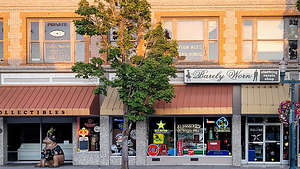 Grants Pass Historic DistrictHome was over 15 hours away, which meant we weren’t going to make it in one day. Smoke was making most inland destinations unpleasant, so we would just have to look for a place to stop when we started getting tired.
Grants Pass Historic DistrictHome was over 15 hours away, which meant we weren’t going to make it in one day. Smoke was making most inland destinations unpleasant, so we would just have to look for a place to stop when we started getting tired.
We decided 9 hours was a good enough chunk of driving, so we found a place to stay in Grants Pass, Oregon, which is actually a destination in itself, especially for those wishing to raft the Rogue River.
After checking into a Knights Inn, we set out to walk up the main drag, which has been designated a National Historic District because of its historic buildings. A big banner proclaiming “It’s the Climate” greets visitors upon entry.
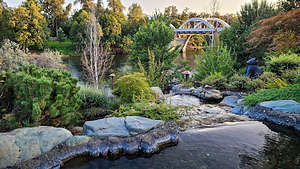 Tap Rock Restaurant gardensWe had two dinner places in mind. One, very popular one was called Tap Rock, and it is located right on the Rogue River with a lovely outdoor dining patio. The other one, the Twisted Cork, was supposed to have the best food in town.
Tap Rock Restaurant gardensWe had two dinner places in mind. One, very popular one was called Tap Rock, and it is located right on the Rogue River with a lovely outdoor dining patio. The other one, the Twisted Cork, was supposed to have the best food in town.
Since we were passing the Twisted Cork first, we decided to stop in to look at the menu. Looked great, but the wait for an outdoor table was 45 minutes. Although we could sit inside right away, because of Covid, we decided to put our name in for an outdoor table. So glad we did, because we later learned that Grants Pass is in the county with the worst outbreak of Covid right now.
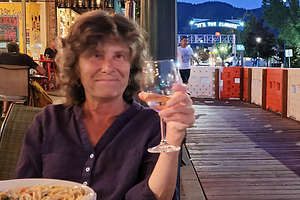 Dinner at the Twisted CorkWe continued walking through town to the riverfront and stopped in Tap Rock only to find that their wait would be an hour and a half. While we were mulling over our decision, which was a tough one because their location was truly spectacular, the Twisted Cork called me to tell me that they were ready to seat us outdoor now.
Dinner at the Twisted CorkWe continued walking through town to the riverfront and stopped in Tap Rock only to find that their wait would be an hour and a half. While we were mulling over our decision, which was a tough one because their location was truly spectacular, the Twisted Cork called me to tell me that they were ready to seat us outdoor now.
Not wanting to eat at 9:30, we headed back to the Twisted Cork, where we had the best dinner of our entire trip. We both had the Creamy Alfredo Linguini - me with Shrimp and Herb with chicken. It was absolutely delicious.
It was a nice way to end a wonderful road trip
Olympic National Park
Monday, August 16, 2021 - 7:15pm by Lolo150 miles and 3 hours from our last stop - 4 night stay
Travelogue
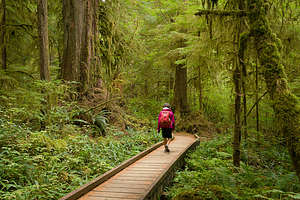 Quinault RainforestOlympic National Park encompasses over 1,400 square miles of the Olympic Peninsula in northwest Washington State. It is a land of tremendous variety with several distinct ecosystems: glacier-covered mountains, 60 miles of rugged Pacific coastline, a lush temperate rain forest, and subalpine meadows full of wildflowers. The western slopes of the mountains receive more than 200 inches a year of precipitation, giving it the distinction of being the wettest climate in the Continental U.S.
Quinault RainforestOlympic National Park encompasses over 1,400 square miles of the Olympic Peninsula in northwest Washington State. It is a land of tremendous variety with several distinct ecosystems: glacier-covered mountains, 60 miles of rugged Pacific coastline, a lush temperate rain forest, and subalpine meadows full of wildflowers. The western slopes of the mountains receive more than 200 inches a year of precipitation, giving it the distinction of being the wettest climate in the Continental U.S.
There is no road that runs through the entire park. While US 101 goes through a few sections of the park, access is mostly from spur roads that lead from US 101 into such areas as Hurricane Ridge, Sole Duc, the Hoh Rain Forest, and Rialto Beach.
Lake Quinault and the Quinault Rainforest
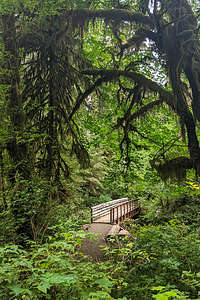 Quinault RainforestSince we were approaching the Park on US 101 from the south, the first section of the National Park we came to was Lake Quinault and the Quinault Rainforest - one of the few parts of the park we hadn’t seen on previous visits.
Quinault RainforestSince we were approaching the Park on US 101 from the south, the first section of the National Park we came to was Lake Quinault and the Quinault Rainforest - one of the few parts of the park we hadn’t seen on previous visits.
The lake was lovely, surrounded by steep mountains and a rainforest near its southern shore. The Quinault Rainforest is one of the three major rainforests on the Olympic Peninsula, receiving 167 inches of rain a year. Today was the only rainy day forecasted so far on our trip, but what better place to spend it than in a rainforest.
There is a popular 0.6-mile Rainforest Trail, but we wanted to do the more ambitious 5-mile Quinault Loop National Recreation Trail, which started up the road a bit across from the USFS Ranger Station.
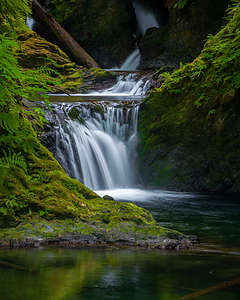 Willaby FallsFrom there we entered a lush forest of huge Douglas firs, Sitka spruce, western hemlock and red-cedar, with lots of ferns and mosses. There were interpretive signs along the way explaining the ecology of the forest. We saw only 2 or 3 people the whole way.
Willaby FallsFrom there we entered a lush forest of huge Douglas firs, Sitka spruce, western hemlock and red-cedar, with lots of ferns and mosses. There were interpretive signs along the way explaining the ecology of the forest. We saw only 2 or 3 people the whole way.
Eventually we came to a junction, which allowed us to continue onto the shorter and therefore more popular Rainforest Trail which led us through a stand of 500-year-old Douglas Firs.
We continued through a tunnel which went under the road towards Willaby Campground and a view of Willaby Falls from a wooden bridge. However, to really see the falls you had to clamber a few yards off trail by the bridge to get a full, unobstructed view of the falls.
From there we walked along the shore of Lake Quinault, eventually coming to the lawn of the historic rustic Lake Quinault Lodge, a very impressive structure that would have been an awesome place to stay. Not exactly cheap though. When I was researching places to stay in the area, I saw that their rooms were around $400 a night and they weren’t even available. Instead we would be lodging at site D011 in the Kalaloch Campground for $13.
The irony was, it didn’t rain a drop our entire time in the Rainforest.
Kalaloch
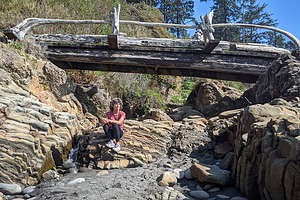 Beach 4However, as we continued our drive up US 101 to Kalaloch, it did start to rain, and not just a drizzle, but a good steady rain. Camping in the back of a 4Runner in the rain is not the greatest experience, so I certainly hoped that the forecast was correct and that it would clear up by mid-afternoon.
Beach 4However, as we continued our drive up US 101 to Kalaloch, it did start to rain, and not just a drizzle, but a good steady rain. Camping in the back of a 4Runner in the rain is not the greatest experience, so I certainly hoped that the forecast was correct and that it would clear up by mid-afternoon.
The rain did pretty much stop when forecasted, but since there was no real need to check into our campground except to sleep, we decided to explore some of the beaches recommended for their tremendous scenery..
Over the next few days we would try to explore the most beautiful beaches along the Olympic coast. Each of them shared the classic Olympic Peninsula traits - broad and sandy with much driftwood washed ashore, and rock outcroppings, called seas stacks, eerily rising from the sea. Despite that, each of them had their own distinct feel and beauty.
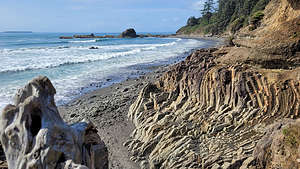 Beach 4We got most of our ideas from our Photographing Washington book, a series that shows the most stunning natural scenery in each of the western states. You don’t have to be a photographer to enjoy spending time on a beautiful beach.
Beach 4We got most of our ideas from our Photographing Washington book, a series that shows the most stunning natural scenery in each of the western states. You don’t have to be a photographer to enjoy spending time on a beautiful beach.
Today, we found time to stroll along three of them.
First up, the rather uncreatively-named Beach 4, just a 3-mile drive north of the Kalaloch Campground. The parking lot was practically full, which was something we would encounter at every beach and trailhead in the park. Since Covid and the discovery by so many Americans that nature is really pretty cool, the national parks have exploded in terms of number of visitors.
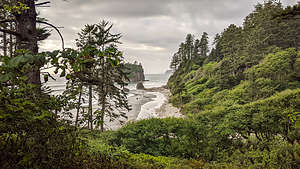 Ruby BeachWe had been to this beach before, in another lifetime back in 2001 when we had gone on a ranger-led guided tour of the tide pools, with our then 10-and 12-year old sons.
Ruby BeachWe had been to this beach before, in another lifetime back in 2001 when we had gone on a ranger-led guided tour of the tide pools, with our then 10-and 12-year old sons.
This beach, which has been designated a marine wildlife preserve, is known as being one of the best locations in Olympic National Park for exploring the pools..
When we got to the trailhead, we checked the tide chart and found out that unfortunately this week the negative low tides, when the pools are exposed and best visited, occurred at ungodly hours in the middle of the night. So no tide pools for us this visit.
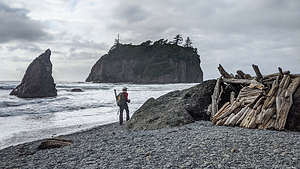 Ruby BeachYou can’t have it all. After all, we did hit Bandon Beach earlier this week at the absolute best timing in terms of tides.
Ruby BeachYou can’t have it all. After all, we did hit Bandon Beach earlier this week at the absolute best timing in terms of tides.
Still, the beach was very beautiful and very much worth the stroll along its rocky shores.
We continued another 5 miles up US 101 to another one of Olympic’s gems, Ruby Beach. This one was so crowded that we had to wait for a parking space.
The 1/4-mile trail down to the beach was steep with good view points of the beach and their signature sea stacks along the way. Unlike some of the other beaches, this one was mostly cobblestones rather than sand.
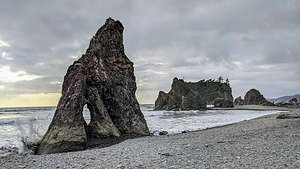 Ruby BeachThere were several interesting sea stacks to admire, including one with two holes that served up all kinds of photographic opportunities. I imagine there is a line up of people during the evening to capture sunset through it.
Ruby BeachThere were several interesting sea stacks to admire, including one with two holes that served up all kinds of photographic opportunities. I imagine there is a line up of people during the evening to capture sunset through it.
Also, Cedar Creek ran alongside the beach a bit before flowing into the Ocean providing kids with a fun, safe place to play in the water. Herb and I set our backpacks up against a large driftwood log near the Creek and sat for awhile just enjoying the surroundings.
Our final beach of the day was Kalaloch Beach right from our campground - not too shabby either.
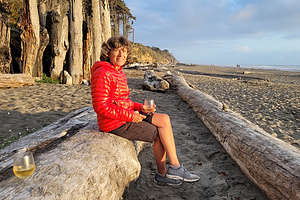 Cocktail hour on Kalaloch BeachWe didn’t go far that night as our main goal was to sit on a driftwood log, sipping wine, and watch the sun set. It didn't disappoint.
Cocktail hour on Kalaloch BeachWe didn’t go far that night as our main goal was to sit on a driftwood log, sipping wine, and watch the sun set. It didn't disappoint.
There was a cute little cairn on our log, which made for interesting photos of sun rays seeping through the gaps between its individual stones.
Tomorrow we would be moving for 2 nights into one of the rustic cabins atop the bluff further down the beach. I was very excited.
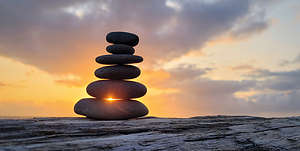 Cairn sunsetSince we couldn’t check into our cabin until 4:00, we had the whole day to explore. After another walk on “our” beach, we headed north with the intention of visiting the Hoh Rainforest. After driving about 20 miles north on US 101, we turned onto the Upper Hoh Road where it was another 18 miles to the Hoh Rainforest Visitor Center.
Cairn sunsetSince we couldn’t check into our cabin until 4:00, we had the whole day to explore. After another walk on “our” beach, we headed north with the intention of visiting the Hoh Rainforest. After driving about 20 miles north on US 101, we turned onto the Upper Hoh Road where it was another 18 miles to the Hoh Rainforest Visitor Center.
Still quite a bit before the Olympic National Park Entrance kiosk, traffic came to a stop and we noticed a sign that said 45 minute wait. Cars would only be allowed in as other cars left. You’ve got to be kidding me. This was the same thing we encountered in Utah when trying to get into Arches National Park. Since Covid, the national park are being overrun with visitors in numbers they have never seen before.
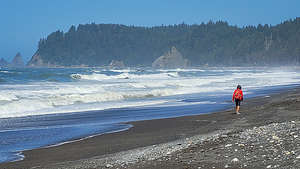 Rialto BeachOh well. We had been to the Hoh Rainforest before and we had just hike in the Quinault Rainforest yesterday, so we decided to make a U-Turn and visit another beach on our list instead..
Rialto BeachOh well. We had been to the Hoh Rainforest before and we had just hike in the Quinault Rainforest yesterday, so we decided to make a U-Turn and visit another beach on our list instead..
After returning to US 101, we continued north through the town of Forks where we then made a left and headed west on WA-110. When we came to the fork with Mora Road, we had to make the decision - Rialto Beach to the right, 2nd Beach to the left. They both were on our list of most beautiful beaches.
Maybe we can do both today, I said. Well, we had to start with one, so we sort of randomly chose Rialto Beach maybe because 2nd Beach wasn’t as inspiringly named.
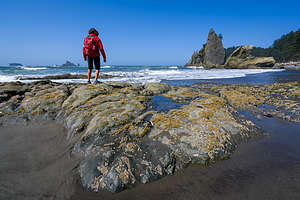 Rialto BeachAt the end of Mora Road, we came to yet another full trailhead parking lot, but fortunately we didn’t have to wait long for someone to pull out.
Rialto BeachAt the end of Mora Road, we came to yet another full trailhead parking lot, but fortunately we didn’t have to wait long for someone to pull out.
I think this was my favorite of the sea stack beaches on the Olympic Peninsula - my overall favorite has to be Bandon Beach in Oregon. Everything seemed a bit more dramatic - the crashing waves, the interesting, upright dead tree that looked like it was reaching out to the sea, and the sea stacks themselves.
The best part of all was that there is a natural arch on a rocky outcropping 1.5 miles down the beach called Hole-In-The-Wall. It looked a bit precarious to get to as you had to clamber over rocks to get to it. The high road was drier but required a bit of minor rock climbing and the lower route was slippery and you were sure to get your feet wet.
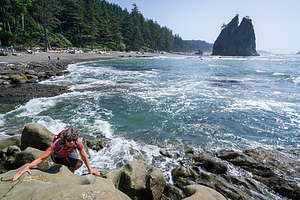 Rialto Beach - rock scrambling to Hole-in-the-WallWe watched people do this for awhile to make sure we wanted to do this, but when I saw enough people a lot less athletic than me, I told Herb let’s go for it. I did take the lower route where I couldn’t fall very far, but did get my sneakers soaked. Herb took the lower route as well, but somehow managed to stay drive.
Rialto Beach - rock scrambling to Hole-in-the-WallWe watched people do this for awhile to make sure we wanted to do this, but when I saw enough people a lot less athletic than me, I told Herb let’s go for it. I did take the lower route where I couldn’t fall very far, but did get my sneakers soaked. Herb took the lower route as well, but somehow managed to stay drive.
Safely around the corner, we walked through the arch to an area that would be really cool in terms of tide pools if the tide was lower. Still, we did get to see several anemones.
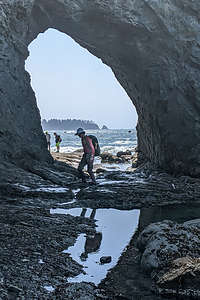 Rialto Beach - Hole-in-the-WallThe tide was coming in, so we didn’t want to wait too long to make our way back from whence we came. It was easier on the way back, because my sneakers were already so wet that I didn't care about stepping in the water.
Rialto Beach - Hole-in-the-WallThe tide was coming in, so we didn’t want to wait too long to make our way back from whence we came. It was easier on the way back, because my sneakers were already so wet that I didn't care about stepping in the water.
It was already 3:00, and I was pretty excited about checking into our cozy rustic cabin, so we decided to save 2nd Beach for another day.
We had stayed in these cabins in 1990, when we brought Andrew here as a one-year-old, so these cabins had a very nostalgic place in our hearts. However, this time would be a lot more quiet and peaceful.
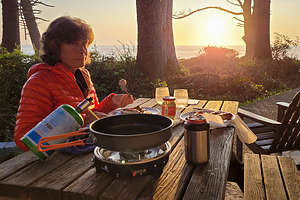 Kalaloch - dinner at our cabinI was a little disappointed that we got the cabin on the very end, where there were trees obstructing our view of the ocean a bit, but it was still very nice. Rather than getting take-out food tonight at the Lodge, we decided to cook one of our backpacking meals on the patio, watching a lovely sunset through the trees.
Kalaloch - dinner at our cabinI was a little disappointed that we got the cabin on the very end, where there were trees obstructing our view of the ocean a bit, but it was still very nice. Rather than getting take-out food tonight at the Lodge, we decided to cook one of our backpacking meals on the patio, watching a lovely sunset through the trees.
After sunset, I convinced Herb that he really wanted to make a fire in the cabin’s wood burning stove. All the fixings were there - logs, kindling, and even a starter block. So, we set up our camping chairs in front of the stove and spent a cozy evening sipping wine before the fire.
Since we had the cabin for two nights, we decided to spend the entire day in the Kalaloch area.
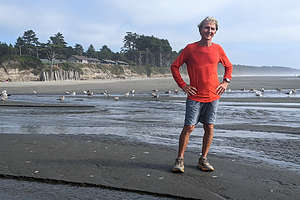 Post-run along Kalaloch BeachWe started off the morning with an invigorating 5-mile run along the beach. I usually hate running on sand, but the sand on this beach was hard enough to make it fun. We did have to take our sneakers off to cross the Kalaloch Creek which flows into the ocean right by the lodge. It was so much fun.
Post-run along Kalaloch BeachWe started off the morning with an invigorating 5-mile run along the beach. I usually hate running on sand, but the sand on this beach was hard enough to make it fun. We did have to take our sneakers off to cross the Kalaloch Creek which flows into the ocean right by the lodge. It was so much fun.
After that we went over to the Kalaloch Lodge to enjoy lunch on their outdoor patio overlooking the Kalaloch Creek we had crossed earlier that morning. The food was good and the view was wonderful.
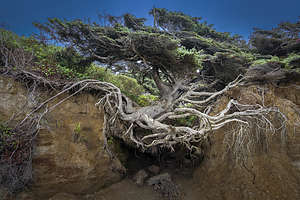 Tree of LifeLater that afternoon, we went for another stroll (and stream crossing) along the Kalaloch Beach. One of the most interesting features we discovered along the way was the Tree of Life (aka Tree Root Cave), a large sitka spruce on the edge of the bluff with its roots totally exposed, hanging onto nothing but air.
Tree of LifeLater that afternoon, we went for another stroll (and stream crossing) along the Kalaloch Beach. One of the most interesting features we discovered along the way was the Tree of Life (aka Tree Root Cave), a large sitka spruce on the edge of the bluff with its roots totally exposed, hanging onto nothing but air.
Somehow this amazing tree has managed to survive, despite having no soil or roots to anchor it in place. The tree seems to defy nature and the frequent storms that topple trees more firmly anchored in the soil.
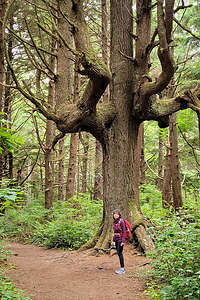 2nd BeachMagic? Probably not, but that doesn’t stop beach strollers from paying homage to it - taking photos standing beneath its exposed roots. Of course, we had to do the same.
2nd BeachMagic? Probably not, but that doesn’t stop beach strollers from paying homage to it - taking photos standing beneath its exposed roots. Of course, we had to do the same.
Another evening, another beautiful sunset and a cozy fire in our cabin.
It had been a lovely stop in Kalaloch, but we weren’t quite done with Olympic National Park yet. I had managed to get a campsite in the Sol Duc Hot Springs Campground, a section of the Park that we had never been to before.
On the way to Sol Duc, we decided to do a side trip to 2nd Beach, the last on my list of best beaches in Olympic National Park. So, when we got to Forks, rather than continuing on US 101, we once again made the turn onto WA-110, but this time we took it all the ways to its end rather than turning right on Mora Road towards Rialto Beach.
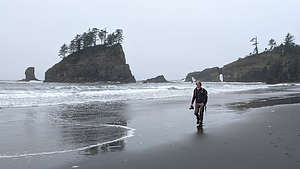 2nd BeachWe headed out on the 2nd Beach trail which took us through a lush, dense forest before leading us out onto another sandy beach with a rocky headland to the north and a large,tree-topped sea stack just offshore.
2nd BeachWe headed out on the 2nd Beach trail which took us through a lush, dense forest before leading us out onto another sandy beach with a rocky headland to the north and a large,tree-topped sea stack just offshore.
It was quite overcast as we strolled up the beach, but with the exception of 2 hours of drizzle a few days ago, we had managed to avoid being rained on during our entire trip.
Sol Duc Hot Springs
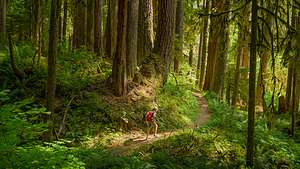 Hike to Sol Duc FallsBack in the car we continued on US 101 towards the Sol Duc Hot Springs resort where we had a campground reservation for that night. This resort is the most commercially developed area in Olympic National Park. Since 1912, tourists have been coming here to experience the medicinal healing of the hot springs.
Hike to Sol Duc FallsBack in the car we continued on US 101 towards the Sol Duc Hot Springs resort where we had a campground reservation for that night. This resort is the most commercially developed area in Olympic National Park. Since 1912, tourists have been coming here to experience the medicinal healing of the hot springs.
Although we planned to partake in a hot spring soak later in the day, our first order of business was a hike to Sol Duc Falls. Conveniently, the trailhead for the hike was right from our campground.
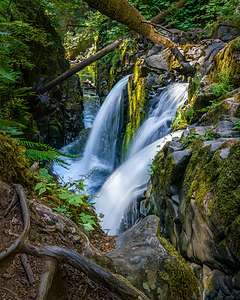 Sol Duc FallsWe left the campground and entered a lovely forest of towering conifers and maples draped in Spanish moss. Not another soul was to be seen until our campground trail converged with the one starting at the major trailhead.
Sol Duc FallsWe left the campground and entered a lovely forest of towering conifers and maples draped in Spanish moss. Not another soul was to be seen until our campground trail converged with the one starting at the major trailhead.
At a little over 2 miles we came to a wooden footbridge over a deep gorge, just 50 yards downstream from where the Sol Duc Falls cascades 50 feet before rushing through the narrow chasm under the bridge.
Wow! With the terrible drought in California this summer, we weren’t used to seeing and hearing water rushing anywhere. It was so refreshingly beautiful and all the vegetation around it was so green and lush..
Although the view from the bridge was good, we found a much better vantage point beyond the bridge by scrambling over some rocks to get down lower to the pool below the falls.
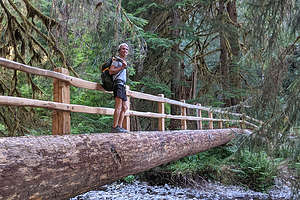 Hike to Sol Duc FallsWhile most people headed back along the trail we hiked in on, we continued on to the recommended Lover’s Lane trail. At first I didn’t like the trail, as it was rocky, unlike the soft pine needle covered trail on the way in. However, it got easier and more interesting and we crossed three footbridges made from huge cut logs, with wooden rails on only one side.
Hike to Sol Duc FallsWhile most people headed back along the trail we hiked in on, we continued on to the recommended Lover’s Lane trail. At first I didn’t like the trail, as it was rocky, unlike the soft pine needle covered trail on the way in. However, it got easier and more interesting and we crossed three footbridges made from huge cut logs, with wooden rails on only one side.
After about 5.5 miles we reached the Sol Duc Hot Springs Resort, where we planned to take a soak, but first we needed to get back to the campground, which was one mile further, to retrieve our bathing suits and towels.
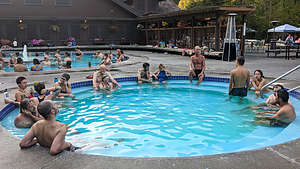 Sol Duc Hot SpringsWe drove back to the resort for the 6:00 - 7:30 soaking session. Prices for adults (12+) are $15, but only $12 for Seniors (62+).
Sol Duc Hot SpringsWe drove back to the resort for the 6:00 - 7:30 soaking session. Prices for adults (12+) are $15, but only $12 for Seniors (62+).
There are three mineral hot spring soaking pools to choose from and one freshwater pool. The small mineral pool is 99°, the medium 104°, and the large one 101°.
We choses to spend an enjoyable hour in the 101 degree one. Even that one was hot enough to make us switch back and forth between soaking and sitting along the pool’s edge, and a dip in the 85° freshwater one.
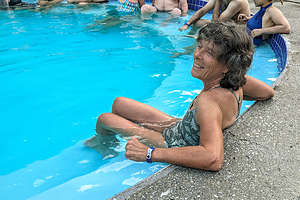 Lolo enjoying Sol Duc Hot SpringsThe next morning we left Sol Duc Hot Springs with the intention of hiking along Hurricane Ridge, the mountainous part of Olympic, but the clouds and threat of rain were definitely not going to be conducive to a hike known for its spectacular view.
Lolo enjoying Sol Duc Hot SpringsThe next morning we left Sol Duc Hot Springs with the intention of hiking along Hurricane Ridge, the mountainous part of Olympic, but the clouds and threat of rain were definitely not going to be conducive to a hike known for its spectacular view.
Still we had had a wonderful time in Olympic - visiting some old favorites and seeing some new.
Time to head towards home, but a quick look at the smoky conditions in the West pretty much shut down any thoughts of further outdoor activity. We hopped on I5 and headed south.
Aberdeen
Sunday, August 15, 2021 - 7:15pm by Lolo200 miles and 4 hours from our last stop - 1 night stay
Travelogue
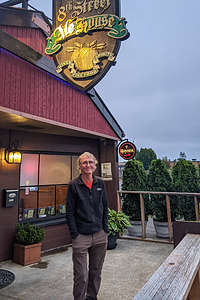 Herb hitting the town in AberdeenWe were able to stay at the beach on Sauvie Island until mid-afternoon, because we didn’t have to drive too far today. All we needed to do was find a place to spend the night somewhere along the way to Kalaloch in Olympic National Park where we would be staying for three nights.
Herb hitting the town in AberdeenWe were able to stay at the beach on Sauvie Island until mid-afternoon, because we didn’t have to drive too far today. All we needed to do was find a place to spend the night somewhere along the way to Kalaloch in Olympic National Park where we would be staying for three nights.
Aberdeen, Washington, was the right distance in that we would arrive in time to go out to dinner, and we would only have another hour to drive tomorrow to get to Olympic National Park. We found an Econo Lodge in walking distance to the 8th Street Ale House, which sounded perfect.
 Aberdeen waterfrontWe had great burgers and beers at the 8th Street Ale House, an establishment obviously frequented by locals, which is always a good sign.
Aberdeen waterfrontWe had great burgers and beers at the 8th Street Ale House, an establishment obviously frequented by locals, which is always a good sign.
After dinner we took a stroll along the Chehalis River waterfront looking at the fishing boats before returning to our room. Tomorrow we would head to Olympic National Park where we had camping reservations in Kalaloch for one night and then a rustic cabin on the bluff for 2 more.
Portland
Friday, August 13, 2021 - 2:30pm by Lolo209 miles and 3.5 hours from our last stop - 2 night stay
Travelogue
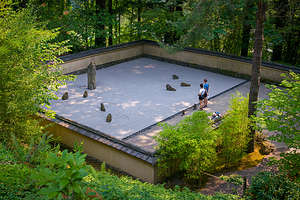 Japanese GardenOriginally, I thought Portland would be the easiest destination to find overnight accommodations as there were numerous options throughout the city with reasonable prices. But then it hit us. We have a Yakima rooftop box on top of our 4 Runner, making us over 7.5 feet high - too tall for parking garages, which was what most Portland hotels offered. We didn’t want to park a vehicle with most of our belongings in it on the streets of Portland, so we started to panic over whether this was feasible.
Japanese GardenOriginally, I thought Portland would be the easiest destination to find overnight accommodations as there were numerous options throughout the city with reasonable prices. But then it hit us. We have a Yakima rooftop box on top of our 4 Runner, making us over 7.5 feet high - too tall for parking garages, which was what most Portland hotels offered. We didn’t want to park a vehicle with most of our belongings in it on the streets of Portland, so we started to panic over whether this was feasible.
I then worked things backwards and went on Booking.com looking for places on the outskirts of the city with free parking. This led me to what seemed to be the ideal option - a studio apartment in the Nob Hill section of Portland in walking distance to Washington Park, with free street parking. The photos of the apartment were lovely and all the reviews raved about its excellent location and proximity to great restaurants.
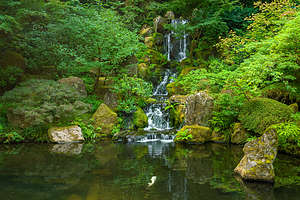 Japanese GardenThe price seemed really reasonable too. We were excited, or at least until we saw that after all the fees were added on, the price nearly doubled. I was crestfallen, but we were in too deep, so we decided to just go for it. A few nights of camping would amortize the amount we were spending for sleeping each night.
Japanese GardenThe price seemed really reasonable too. We were excited, or at least until we saw that after all the fees were added on, the price nearly doubled. I was crestfallen, but we were in too deep, so we decided to just go for it. A few nights of camping would amortize the amount we were spending for sleeping each night.
Since we couldn’t check in our rental until 4:00, we decided to head directly to Washington Park, Portland’s crown jewel. Every city needs its monumental green space. New York has Central Park, San Francisco its Golden Gate Park, etc. Portland has its Washington Park, encompassing 130 acres of forest, a Japanese Garden, the international Rose Test Garden, a zoo, and more. It was modeled on European parks, with winding drives, fountains, statuary, and formal gardens. It was lovely.
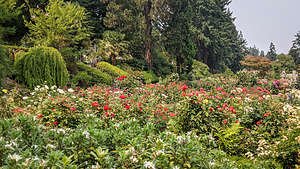 International Rose GardenWe started our visit at the Japanese Garden where we were fortunate enough to find nearby parking. There was a significant crowd waiting to buy tickets. The Gardens are actually five separate gardens linked by winding paths:a Tea Garden, a Strolling Pond Garden, a Natural Garden, a Flat Garden, and a Sand and Stone Garden.
International Rose GardenWe started our visit at the Japanese Garden where we were fortunate enough to find nearby parking. There was a significant crowd waiting to buy tickets. The Gardens are actually five separate gardens linked by winding paths:a Tea Garden, a Strolling Pond Garden, a Natural Garden, a Flat Garden, and a Sand and Stone Garden.
They were designed in the 1960s by Takuma Tono, a renowned Japanese landscape architect, and recognized by the Japanese ambassador to the United States as “the most beautiful and authentic Japanese garden in the world outside of Japan.”
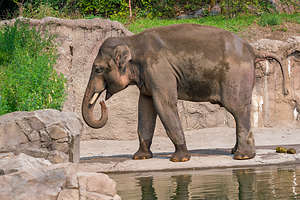 Portland ZooTickets were $18.95 for adults and $16.25 for Seniors (65+).
Portland ZooTickets were $18.95 for adults and $16.25 for Seniors (65+).
From there we walked across the road to the International Test Rose Garden, where there are 4.5 acres of beautiful formal rose gardens with over 6,800 rose bushes representing 557 different varieties. It is one of 24 gardens in the U.S. that test new rose varieties for vigor, disease resistance, color, flower production, and fragrance.
From the garden there can on clear days be a wonderful view of Portland with Mount Hood in the background. Unfortunately, the smoke from various wildfires obscured the mountain.
I forgot to mention that Portland was experiencing a heatwave and it was well into the mid-90s, so our next activity was probably not the wisest. We decided to go to Oregon Zoo all the way at the other side of Washington Park, but rather than take the free shuttle, we thought it might be nice to see the whole park by walking there.
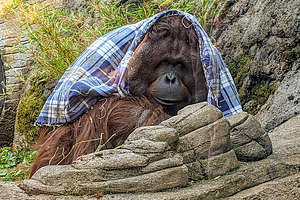 Portland ZooThe walk there was a bit more intense than we anticipated. Rather than winding paths through green areas and play areas, such as in Central or Golden Gate Parks, we were hiking for 3 miles or so up and down steep dirt paths through a pretty thick forest.
Portland ZooThe walk there was a bit more intense than we anticipated. Rather than winding paths through green areas and play areas, such as in Central or Golden Gate Parks, we were hiking for 3 miles or so up and down steep dirt paths through a pretty thick forest.
Finally, we arrived at the zoo, which was practically empty, due to the heat. We knew animal viewing would not be that great because they would all be hiding in the shade and not moving, but since we were here, we decided to buy tickets and go anyway.
The zoo is arranged in five areas that range across different continents and ecosystems: Great Northwest, Elephant Lands, Africa, Primate Forest and Discovery Zone. Within each zone you’ll find animals and habitats such as Africa Savanna or Polar Passage that recreate the habitats of specific animals.
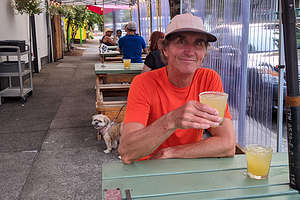 Herb enjoying his $5 MargaritaWe did get to see see elephants, primates, giraffes, bears, flamingos, eagles, and much more,
Herb enjoying his $5 MargaritaWe did get to see see elephants, primates, giraffes, bears, flamingos, eagles, and much more,
but It was a bit sad, as the animals definitely were not active and did not look particularly happy or comfortable. We weren’t either, so we took the free park shuttle back to our car by the Japanese Garden and drove over to Lovejoy Avenue about a mile and a half away to check into our home for the next two nights.
We had a lovely little studio apartment in the fashionable Nob Hill neighborhood, known for its ornate Victorian houses, tree-lined streets, and a thriving dining scene.
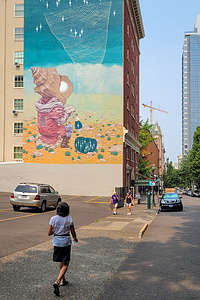 Walking tour of PortlandThat evening we strolled over to NW 23rd Avenue, the trendy main drag with tons of restaurants, bars, and shops. We didn’t go too far before being drawn in by the bustling crowd at Santa Fe Taqueria and its $5 margaritas enticing sign. We sat at an outdoor table, had a delicious meal and listened to live music from the corner across the street.
Walking tour of PortlandThat evening we strolled over to NW 23rd Avenue, the trendy main drag with tons of restaurants, bars, and shops. We didn’t go too far before being drawn in by the bustling crowd at Santa Fe Taqueria and its $5 margaritas enticing sign. We sat at an outdoor table, had a delicious meal and listened to live music from the corner across the street.
The next day was our big walking tour of Portland, so we set off with rather an ambitious itinerary ahead of us.
First stop, the famous Powell’s City of Books. “City” of books was not an overstatement. This place was incredible, taking up an entire block square and three stories tall. Its miles of bookshelves contained new, used, and out-of-print books, and I dare anyone to stump them in having a book in their vast collection. You could literally spend days browsing their shelves and only making a dent in them.
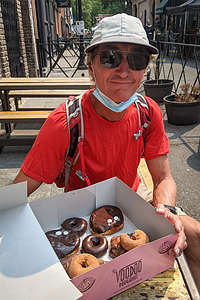 Herb enjoying his giant box of Voodoo DonutsNext, we moved on to a less cerebral activity - Voodoo Donuts, the iconic and highly popular donut shop that refers to its bakers as artists. Needless to say, there was a very long line wrapping around the corner, but to my surprise, Herb had no hesitation waiting - that man loves a good pastry.
Herb enjoying his giant box of Voodoo DonutsNext, we moved on to a less cerebral activity - Voodoo Donuts, the iconic and highly popular donut shop that refers to its bakers as artists. Needless to say, there was a very long line wrapping around the corner, but to my surprise, Herb had no hesitation waiting - that man loves a good pastry.
The menu was overwhelming, with over 50 cleverly named, mouth watering choices. We were quite conservative in both quantity and content. I talked Herb down from a dozen to two each of Portland Cream, Apple Fritter, Cinnamon Sugar Cake, and Double Chocolate.
They were packed in a pink box the size of Delaware that we now had to cart around the city on our tour. Herb took one for the team and ate one of the giant Apple Fritters and a Portland Cream immediately upon exiting the store and I joined him in his efforts with one of the Double Chocolates.
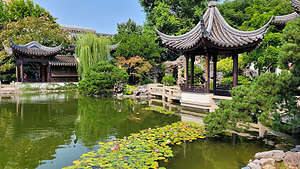 Lan Zu Chinese GardenDown to 5, we asked for some bags instead of the box and stuffed them in our backpacks, discarding the enormous pink box. With temps in the 90s, I was a bit worried about what the state of my other Double Chocolate would be at the end of the day.
Lan Zu Chinese GardenDown to 5, we asked for some bags instead of the box and stuffed them in our backpacks, discarding the enormous pink box. With temps in the 90s, I was a bit worried about what the state of my other Double Chocolate would be at the end of the day.
We forged on. Next stop, the Lan Zu Chinese Garden, a replica of a formal garden built in the style of the Ming Dynasty. Its creation was a joint effort between craftspeople in Portland and its Chinese sister city. It is the largest traditional Chinese garden in the U.S.
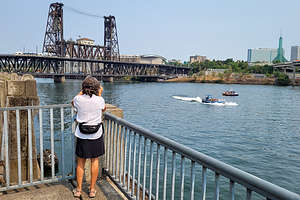 Portland's Steel BridgeThe peaceful setting served as a sharp contrast to the noisy streets and higher buildings of downtown Portland that surrounded it - an oasis in a sea of modern urban life.
Portland's Steel BridgeThe peaceful setting served as a sharp contrast to the noisy streets and higher buildings of downtown Portland that surrounded it - an oasis in a sea of modern urban life.
The landscaping, ponds, and buildings were beautiful and if it weren’t for my concerns about my Double Chocolate donut melting in my backpack, I would have been in a state of perfect peace and harmony. .
After leaving the Chinese Gardens we headed to the Tom McCall Waterfront Park. A friend of mine who recently lived in Portland warned us that this was often the location for Proud Boy / Antifa protests, so to be wary. Fortunately, today there were no protesters to be found. Just children cooling off in the fountains. I was very tempted to take a run through them myself.
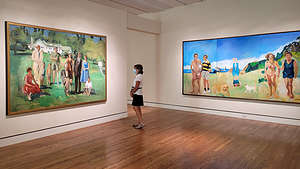 Portland Art MuseumWe ended our tour at the Portland Art Museum, which I would have to say wasn’t my favorite art museum. Maybe we were just hot and tired - we had already walked over 8 miles, and were a bit overwhelmed by the degree of homelessness in the city, which is so very sad.
Portland Art MuseumWe ended our tour at the Portland Art Museum, which I would have to say wasn’t my favorite art museum. Maybe we were just hot and tired - we had already walked over 8 miles, and were a bit overwhelmed by the degree of homelessness in the city, which is so very sad.
We headed back to our apartment for a well-needed nap, and maybe a donut.
That evening, we headed back out to NW 23rd Avenue to people watch and have dinner. This time we ate at Thai Bloom! (that ! is not a typo - it is actually part of the restaurant’s name) where we had a delicious dinner and my first ever Tamarind Margarita. It will not be my last.
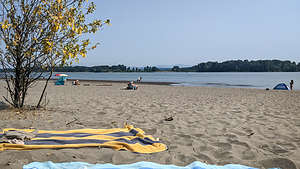 Sauvie IslandAfter the last two day’s aggressive march though Portland trying to see everything, we needed some down time, so after checking out of our rental, we headed to Sauvie Island, ten miles northwest of Portland at the confluence of the Willamette and Columbia Rivers, reach via the Sauvie Island Bridge on Highway 30.
Sauvie IslandAfter the last two day’s aggressive march though Portland trying to see everything, we needed some down time, so after checking out of our rental, we headed to Sauvie Island, ten miles northwest of Portland at the confluence of the Willamette and Columbia Rivers, reach via the Sauvie Island Bridge on Highway 30.
The southern half of the island is predominantly rural farmland, while the northern half is a wildlife refuge with sandy beaches along the northeastern side of the island. Parking permits are required in all wildlife areas on the island (which includes the beaches). Daily permits are $10 and can be purchased at several convenience stores on the island.
The island was lovely and we saw many bicyclists out enjoying a Sunday morning ride along its 12-mile “hill-less” loop.
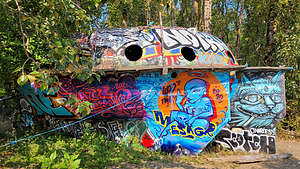 The Floating SaucerWe were early enough to easily find a parking spot along a lovely sandy beach, where we spent the day relaxing, reading, and dipping ourselves in the Columbia River to get cool. It was a well-needed down day.
The Floating SaucerWe were early enough to easily find a parking spot along a lovely sandy beach, where we spent the day relaxing, reading, and dipping ourselves in the Columbia River to get cool. It was a well-needed down day.
I did take a short stroll down the beach in search of a geocache that sounded very interesting. It was called "floating saucer." As my phone told me I was getting closer, I glanced towards the edge of the woods where I found a very surprising sight - a large submarine / flying saucer like object colorfully painted all over with graffiti.
A nearby signed gave its history: This 31-foot paddle wheel boat was built in 1973 in Hubbard, Oregon, by an engineer named Richard Ensign. It took him two years and cost $10,000. It could sleep 12 people and had a wood stove. It was launched on the Willamette River, went through the locks at Willamette Falls, and was front page of the Oregonian. It was dubbed the "floating saucer." It mostly likely was left here by the February 1996 flood.
I ever did find the geocache, but I am very glad that the search for it brought me here. Who would have thought?
Now onto more action.
Oregon Dunes National Recreation Area
Thursday, August 12, 2021 - 1:30pm by Lolo40 miles and 0.75 hours from our last stop - 1 night stay
Travelogue
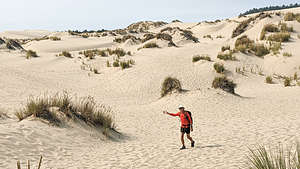 John Dellenback Trail along the Umpqua DunesOf course before leaving Bandon, I had planned out our next destination and where we could camp. Not only did I find and reserve one campsite, but I reserved two because I wasn’t sure yet which one would be better to accomplish what we wanted to do, which was hike the John Dellenback Dunes Trail in the Oregon Dunes National Recreation Area.
John Dellenback Trail along the Umpqua DunesOf course before leaving Bandon, I had planned out our next destination and where we could camp. Not only did I find and reserve one campsite, but I reserved two because I wasn’t sure yet which one would be better to accomplish what we wanted to do, which was hike the John Dellenback Dunes Trail in the Oregon Dunes National Recreation Area.
National Park camping is quite inexpensive, and even more so with a Seniors Lifetime Pass, which cuts the price in half. So, the downside of doing this was the loss of $10 on the campsite we did not use.
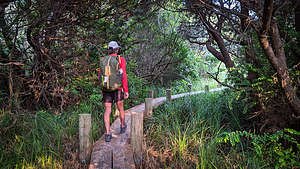 From dune to forest to oceanOne campground was the Eel Creek USFS Campground where the John Dellenback trail started. The second one was Umpqua Sand Camping, an OHV area on the beach, which would assuredly be noisy with dune buggies racing up and down the beach all day and night. Also, we weren’t sure if we would be able to find the other end of the John Dellenback Dunes Trail from there. After all, the Oregon Dunes NRA is the largest expanse of coastal sand dunes in North America, stretching 40 miles along the Oregon Coast from Florence to Coos Bay.
From dune to forest to oceanOne campground was the Eel Creek USFS Campground where the John Dellenback trail started. The second one was Umpqua Sand Camping, an OHV area on the beach, which would assuredly be noisy with dune buggies racing up and down the beach all day and night. Also, we weren’t sure if we would be able to find the other end of the John Dellenback Dunes Trail from there. After all, the Oregon Dunes NRA is the largest expanse of coastal sand dunes in North America, stretching 40 miles along the Oregon Coast from Florence to Coos Bay.
So, after first stopping at Eel Creek, we decided to stay there, as it was quiet and the trailhead for our planned hike was just a few campsites away.
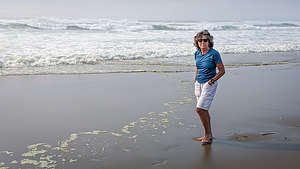 The ocean part of the John Dellenback TrailThe hike was listed as a 3 (out of 5) in difficulty because of having to plod along deep, soft sand, but a 9 (out of 10) in scenic beauty. The campground host we spoke to felt like it was more of a 4 in difficulty.
The ocean part of the John Dellenback TrailThe hike was listed as a 3 (out of 5) in difficulty because of having to plod along deep, soft sand, but a 9 (out of 10) in scenic beauty. The campground host we spoke to felt like it was more of a 4 in difficulty.
Ok, so this hike could double as a workout. We set off from the trailhead in the campground and immediately began climbing a steep, yet short, deep sandy section through a conifer-forest before coming out to the dunes.
Theoretically, there were poles with blue stripes on top used as trail markers, but so far we couldn’t see one. Herb had a Gaia trail downloaded on his watch, so we followed that towards a large grouping of conifer trees atop a dune. I’ve been to many deserts on our travels, but never saw one with so many trees.
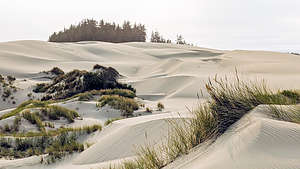 Umpqua Dunes along the John Dellenback TrailThese tree islands are a prominent topographic feature of the Oregon Dunes and make for a very different dune visual experience. I don’t quite understand the explanation for these tree islands, but it has something to do with the fact that these are oblique dunes with long gradual slopes on the west (ocean) side and much steeper slopes on the east side. Over many years wind stripped away the sand on the east (inland) side down to the permanently wet sand where water-loving vegetation can thrive. These areas are called deflation plains.As the dunes move eastward, the plants of the deflation plain also spread eastward.
Umpqua Dunes along the John Dellenback TrailThese tree islands are a prominent topographic feature of the Oregon Dunes and make for a very different dune visual experience. I don’t quite understand the explanation for these tree islands, but it has something to do with the fact that these are oblique dunes with long gradual slopes on the west (ocean) side and much steeper slopes on the east side. Over many years wind stripped away the sand on the east (inland) side down to the permanently wet sand where water-loving vegetation can thrive. These areas are called deflation plains.As the dunes move eastward, the plants of the deflation plain also spread eastward.
Trudging through the sand was nowhere nearly as difficult as the hiking book or campground host led us to believe. Plus, we finally were able to find and follow the posts with the blue stripe on top. Good thing because we eventually entered a pretty thick forest and I don’t know how we would have found the opening without the post.
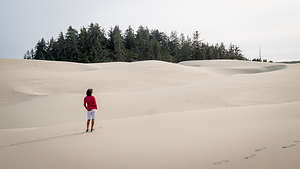 Umpqua DunesThis part of the hike was really cool as it led us on an easy dirt surface with the occasional boardwalk to get us over the wetter areas. There was even Spanish moss hanging from some of the trees. It was hard to believe we had just left sand dunes.
Umpqua DunesThis part of the hike was really cool as it led us on an easy dirt surface with the occasional boardwalk to get us over the wetter areas. There was even Spanish moss hanging from some of the trees. It was hard to believe we had just left sand dunes.
Eventually we popped out on a beautiful beach with crashing surf. There was no sign of OHV vehicles, or anyone for that matter, so I think we made a good choice staying at Eel Creek because we never would have been able to get to this trail from the OHV camping area.
The way back was much easier to navigate now that we knew the way. All in all it was a 6-mile hike, and much less difficult than we anticipated.
Bandon Beach
Tuesday, August 10, 2021 - 11:15am by Lolo240 miles and 5 hours from our last stop - 2 night stay
Travelogue
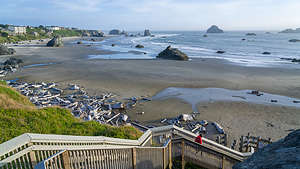 Coquille Point staircase to Bandon BeachI was pretty excited about Bandon. The photos of its uniquely shaped sea stacks were a definite draw. Unlike many of the sea stacks along the coast, which are large mounds with trees sprouting from their tops, these were distinct enough to have names, like Face Rock and Wizard’s Hat.
Coquille Point staircase to Bandon BeachI was pretty excited about Bandon. The photos of its uniquely shaped sea stacks were a definite draw. Unlike many of the sea stacks along the coast, which are large mounds with trees sprouting from their tops, these were distinct enough to have names, like Face Rock and Wizard’s Hat.
So, before leaving home, I booked a night at the Lighthouse Cove Inn near Bandon’s historic Old Town. I have to admit I am a sucker for names that imply coziness, so I was a bit disappointed that there was not a lighthouse in sight except on their signage. However, the location was great, and to their credit, there actually technically was a Lighthouse out in the cove beyond the Old Town.
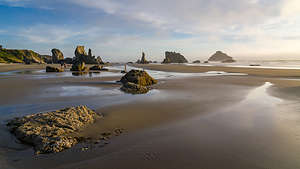 Bandon Beach during sunsetDespite the extremely windy conditions, we decided to head out to the beach anyway. The sea stacks are located between Coquille Point and Face Rock, both of which have parking lots and wooden steps down to the beach. We parked at the nearer Coquille Point next to the Bandon Beach Motel, which had an incredibly good location, perched on the bluff above the beach.
Bandon Beach during sunsetDespite the extremely windy conditions, we decided to head out to the beach anyway. The sea stacks are located between Coquille Point and Face Rock, both of which have parking lots and wooden steps down to the beach. We parked at the nearer Coquille Point next to the Bandon Beach Motel, which had an incredibly good location, perched on the bluff above the beach.
Being the planner I am, I am always plotting where we will sleep the next night, so I walked into the Bandon Beach Motel to inquire about availability for the following night. They had one opening, so I grabbed it. Now, I could relax and enjoy the evening. Tomorrow, however, I would be back to worrying about the next night. I think I definitely need some serious mindfulness practice to learn to be more in the moment.
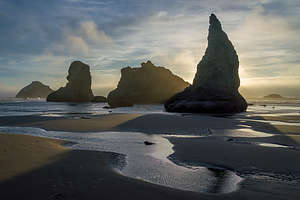 Bandon Beach during sunsetWe headed down the wooden steps to the beach where we were pelted with sand from the 25+ mph winds. Otherwise, conditions were perfect in that it was a receding tide, which allowed for photographing stunning reflections of the stacks in the puddles left behind, while not getting swept out to sea.
Bandon Beach during sunsetWe headed down the wooden steps to the beach where we were pelted with sand from the 25+ mph winds. Otherwise, conditions were perfect in that it was a receding tide, which allowed for photographing stunning reflections of the stacks in the puddles left behind, while not getting swept out to sea.
The sand was hard, which made for easy walking, so we walked the mile or so to Face Rock. Except for a few dedicated photographers, the beach was pretty deserted - I imagine due to the fierce winds. Despite that, it was an absolutely beautiful sunset and we enjoyed ourselves immensely. It was very exhilarating.
The next morning, I convinced Herb to go for a run with me, so we set off through the Old Town, running along the waterfront, past Coquille Point and onto Face Rock - not on the beach this time, but along the road.
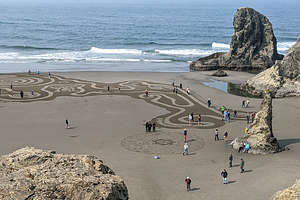 Circles in the SandFrom the overlook above Face Rock, we looked down at a spectacular labyrinth created in the sand, with dozens of people wandering its intricate weaving paths. These labyrinths, which are created on 2 sets of 3 or 4 consecutive days each month during super low tides, are the brain child of Denny Dyke, who has been doing this for over a decade. His intention in creating these “Circles in the Sand” is to share love, joy, and kindness and provide a place for peaceful meditation.
Circles in the SandFrom the overlook above Face Rock, we looked down at a spectacular labyrinth created in the sand, with dozens of people wandering its intricate weaving paths. These labyrinths, which are created on 2 sets of 3 or 4 consecutive days each month during super low tides, are the brain child of Denny Dyke, who has been doing this for over a decade. His intention in creating these “Circles in the Sand” is to share love, joy, and kindness and provide a place for peaceful meditation.
It takes him about 2 hours to create his labyrinth and then the waiting crowd is allowed to enter and wander its twisting paths. He personally greets each person entering the maze and allows them to select one of the many moonstones he has in a basket.
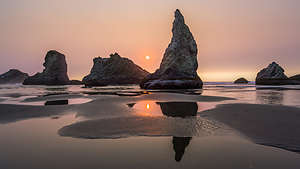 Bandon Beach Night 2Each afternoon, the tide comes in and washes it away.
Bandon Beach Night 2Each afternoon, the tide comes in and washes it away.
For now, we would continue our run, but vowed to come back tomorrow morning to experience it first hand.
We couldn’t check into our 2nd Bandon motel until 4:00, so after showering and checking out of the Lighthouse Cove Inn, we wandered the Old Town and looked for a place to have lunch. Some very positive Yelp reviews led us to the Bandon Fish Market, where a long line extending out into the parking lot confirmed its popularity.
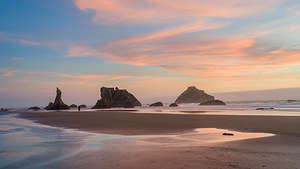 Bandon Beach during sunsetIt was a bit of a wait, both to place our order and for it to be ready, but it was no hardship wandering along the lovely waterfront during our wait. Bandon is a very artsy town with beautiful wood-carved benches and sculptures to enjoy during a stroll. Also, along the waterfront fence were dozens of original paintings done by both the school children and adults of Bandon. Visitors were encouraged to vote for their favorites.
Bandon Beach during sunsetIt was a bit of a wait, both to place our order and for it to be ready, but it was no hardship wandering along the lovely waterfront during our wait. Bandon is a very artsy town with beautiful wood-carved benches and sculptures to enjoy during a stroll. Also, along the waterfront fence were dozens of original paintings done by both the school children and adults of Bandon. Visitors were encouraged to vote for their favorites.
Finally, our name was called and we sat on one of those beautiful benches to enjoy our Fish and Chips and Dungeness Crab sandwich - the crab was for me as Herb is allergic to shellfish (poor guy).
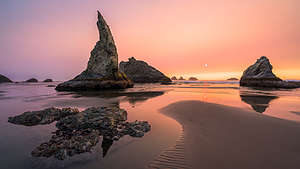 Bandon Beach Night 2After lunch, we headed over to the Bandon Beach Motel to check in. What an incredible location!! Besides being just a stone’s throw from the wooden steps leading down to the beach from Coquille Point, there was the lovely ½-mile Coquille Point loop trail atop the bluff with interpretive displays about the ecology of the region.
Bandon Beach Night 2After lunch, we headed over to the Bandon Beach Motel to check in. What an incredible location!! Besides being just a stone’s throw from the wooden steps leading down to the beach from Coquille Point, there was the lovely ½-mile Coquille Point loop trail atop the bluff with interpretive displays about the ecology of the region.
That evening, we strolled back down to the beach to once again enjoy the sun setting over the sea stacks. Conditions were perfect - low tide and low winds. Pretty perfect. It was an absolutely lovely evening.
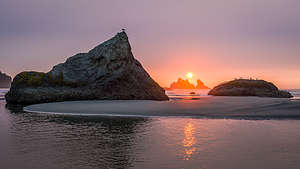 Bandon Beach Night 2The next morning we set out once more down the Coquille Point steps, this time to wander over to and hopefully wander through the Circles in the Sand Labyrinth, about a mile walk along the beach.
Bandon Beach Night 2The next morning we set out once more down the Coquille Point steps, this time to wander over to and hopefully wander through the Circles in the Sand Labyrinth, about a mile walk along the beach.
Somewhere along that stroll, I left Herb behind to photograph the stacks and entered the maze myself, first collecting my chosen moonstone from Denny Dyke, the creator of this incredible labyrinth. Although the maze was probably smaller than a football field, it took quite a bit of time because of all the twists and turns along the way.
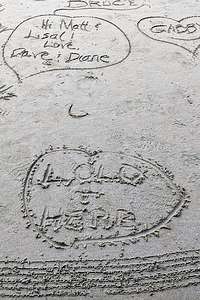 Bandon Beach Night 2When I exited the maze, I stopped to add a heart with “Herb + Lolo” to the large collection at the end of the labyrinth.
Bandon Beach Night 2When I exited the maze, I stopped to add a heart with “Herb + Lolo” to the large collection at the end of the labyrinth.
I scanned the beach for Herb and finally spotted him in the labyrinth. He was so close but yet so far from finishing due to the growing crowds and twists and turns.
What a wonderful stop Bandon had been and we were so so lucky that our visit took place during one of its super low tides so that we could experience both the sea stack reflections at sunset and the Circles in the Sand labyrinth.
.
Humboldt Redwoods State Park
Tuesday, August 10, 2021 - 11:00am by Lolo180 miles and 3.5 hours from our last stop
Travelogue
 Lolo stalking the fallen Dyerville GiantAfter about 3 and a half hours of driving towards Bandon, we decided to stop and stretch our legs amongst the giant California redwood trees of Northern California.
Lolo stalking the fallen Dyerville GiantAfter about 3 and a half hours of driving towards Bandon, we decided to stop and stretch our legs amongst the giant California redwood trees of Northern California.
The fact that there are still so many groves of these incredible trees to enjoy, which happen to be the largest and tallest on earth, was not a given. After the gold rush, many miners that failed to strike it rich with gold turned to harvesting these giant redwoods. By the early 1900s, these priceless forests were badly threatened by years of unrestricted clear cut logging.
However, today, thanks to the foresight and work of the state of California and the Save the Redwoods League, hundreds of groves have been acquired and protected for our enjoyment. In 1968, Redwood National Park was created for the purpose of cooperative forest management with three other state parks: Jedediah Smith, Del Norte, and Prairie Creek. Today Redwood National and State Parks encompasses 133,000 acres and protects 45% of all remaining coast redwood old-growth forests.
Although you don’t even have to leave your car to enjoy these majestic groves along the scenic Redwood Highway, to truly experience them, you need to get out of the car and walk amongst them.
There are so many choices of groves to visit. We chose to drive the 30-mile-auto-tour route known as the Avenue of Giants, which pretty much parallels US 101, stopping to stroll the ½-mile loop through the Founders Grove.
There are two “special trees” along this loop. The Founders Tree, which is a memorial to the Save-the-Redwoods-League, and the Dyerville Giant, which was once the tallest tree in this region, clocking in at 370 feet. Unfortunately, the Giant fell back in 1991.
Refreshed, we continued on US 101 into Oregon. The only noteworthy thing that occurred along the drive is that we thought we saw an orange construction cone in the lane in front of us. The weird thing was the construction cone appeared to be moving - that’s because it was. This faux construction cone was actually a tiny capsule-like motorized vehicle, which definitely did not belong on a highway. At a traffic light, the top opened and a shirtless young man popped up to look around before enclosing himself back in his very strange vehicle and continuing on his merry way. I am glad I am not his mother.
